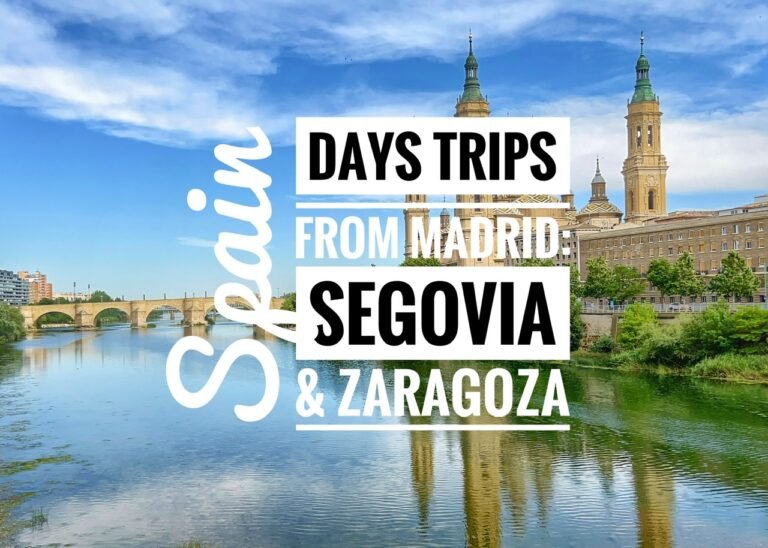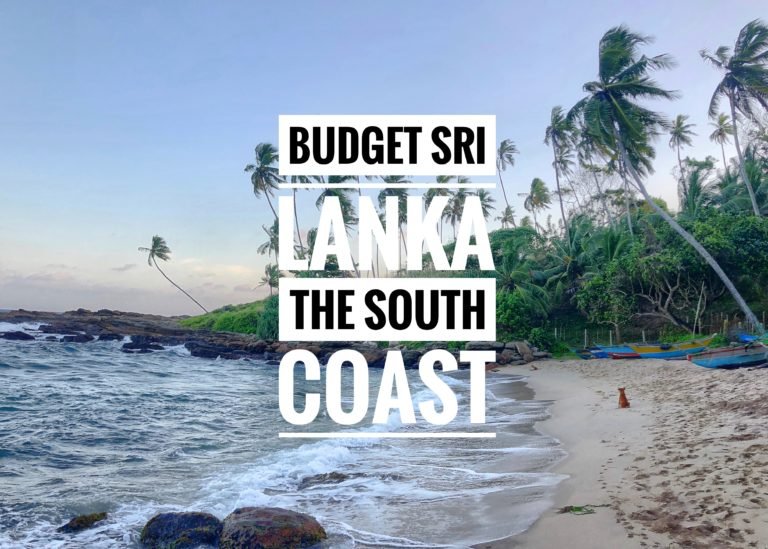
Day One: Kovachevitsa, Leshten, Gotse Delchev & Ognyanovo
It didn’t take long to realize that Sandanski may be slightly more challenging when it comes to public transportation than other parts of Bulgaria, so in order to get to the other side of the Pirin Mountains and continue to have our freedom, we rented a second car for another overnight SW Bulgaria off-the-beaten path Odyssey. Like the first time, it cost $28/day, which we rented for two.
While in reality its main hub of Gotse Delchev is about 1.5 hours away, the east side of the Pirin Mountains has a distinctively different flavor than the west side. Its isolation becomes apparent and although it is still ringed by mountains, including the western Rhodopes, the views of the snow-capped peaks get quite a bit more visible and alluring. Alongside the orthodox churches, there are also many more mosques dropped throughout the landscapes inviting diversity and warmth. One thing we’ve noticed, however, is everyone keeps their bell-ringing, and their call to prayers silent.
Furthermore, like Melnik, the architectural reserves on the other side are utterly spellbinding. You might be curious what an architectural reserve is. Well, in Bulgaria, it’s code for “Aww! I wanna squeeze the cheeks of this village” much like Pueblo Magicos in Mexico. So, of course, we’ve made it a goal to squeeze as many of these cheeks as possible.
The first day of the road trip took us to two of them…Kovachevitsa and Leshten, as well as some more functional and livable places, including where we stayed in a village loaded with more thermal action…Ognyanovo.
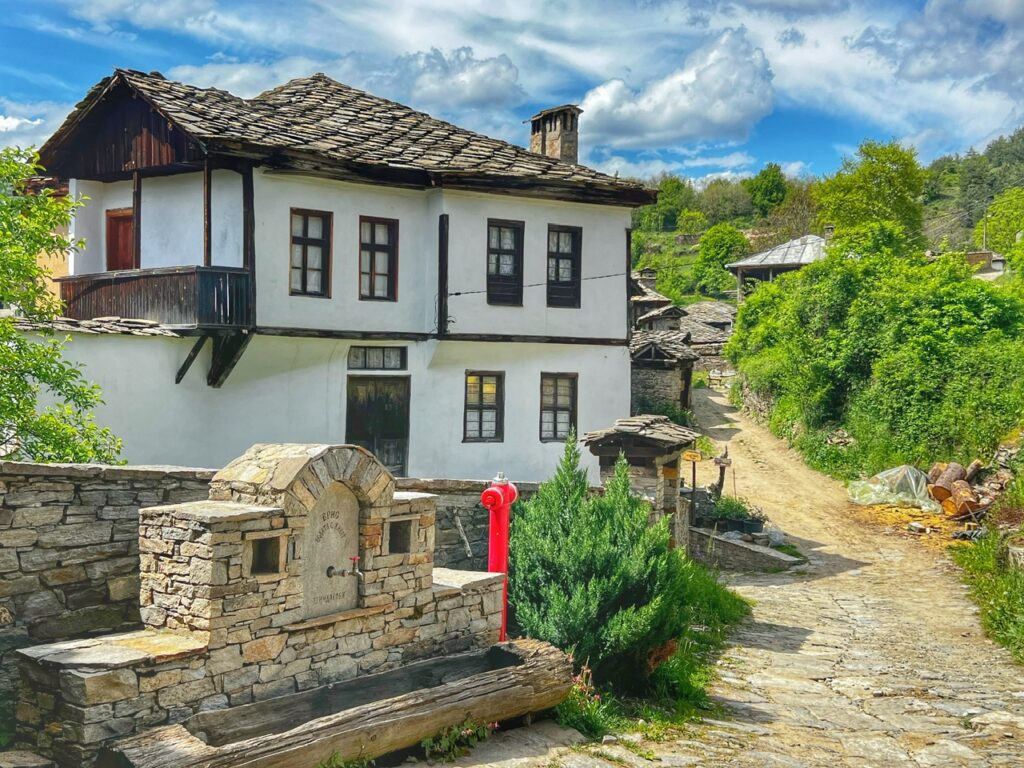
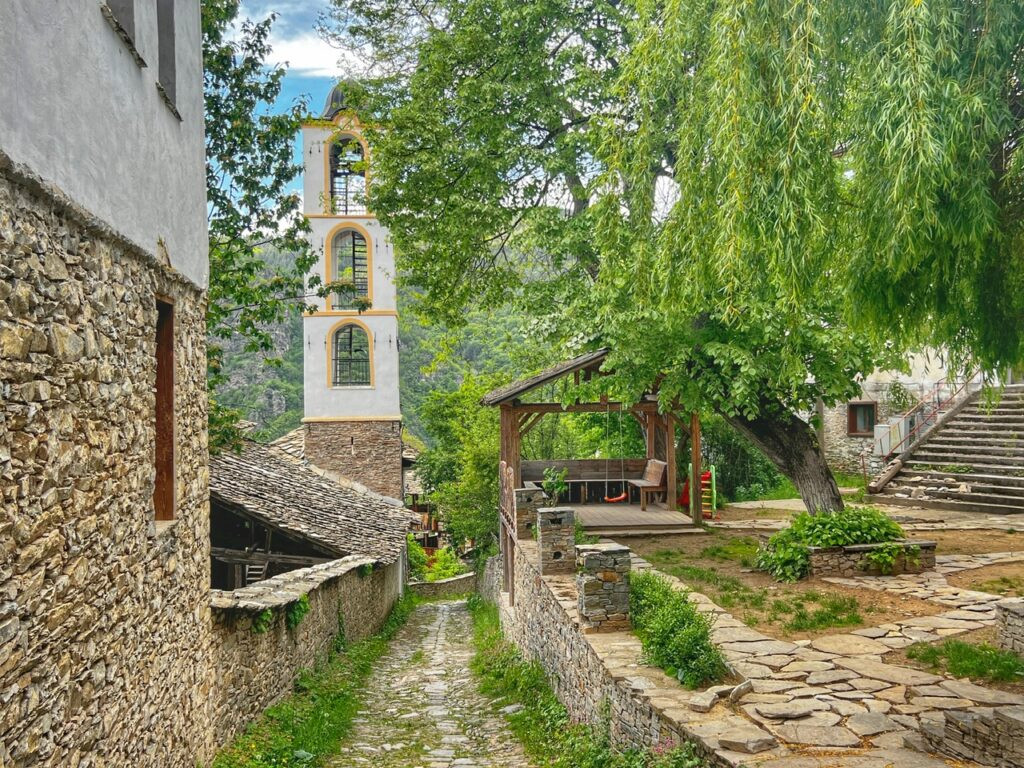
At two hours from Sandanski, Kovachevitsa was the furthest point for day one. It’s the kind of contemplative village you could easily amble in for a half a day, because with every bend and turn on its cobblestoned streets, an urge prevails to discover what’s around the next corner (so you can take 50 more photos.)
Tucked high in the Western Rhodope Mountains, you feel like you’re being transported to another world….a world with only 50 permanent residents…a few of which came out to say Zdraveite. One woman, who was even providing a classical music ambience from her terrace, even spoke English so we chatted for a bit.

Kovachevitsa is thought to be founded in the 17th Century by Bulgarian Christians fleeing forced conversion to Islam during the Ottoman Empire’s Islamization campaigns in nearby regions. Because it was so remote, it made it ideal for preserving Christian and Bulgarian traditions.
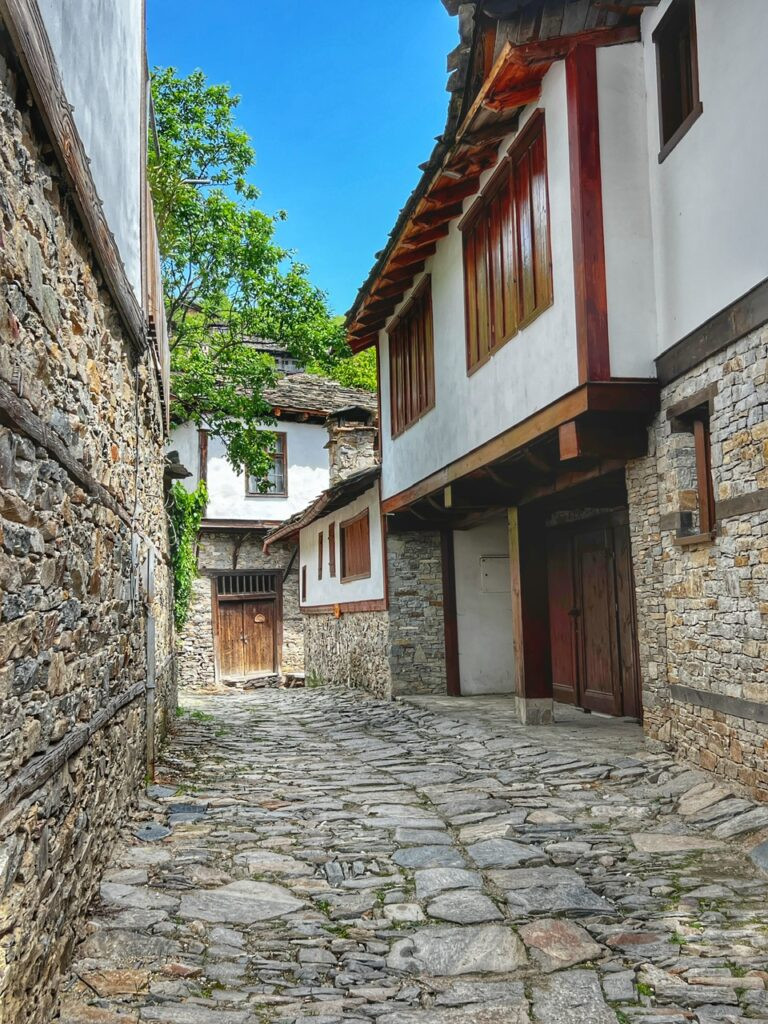
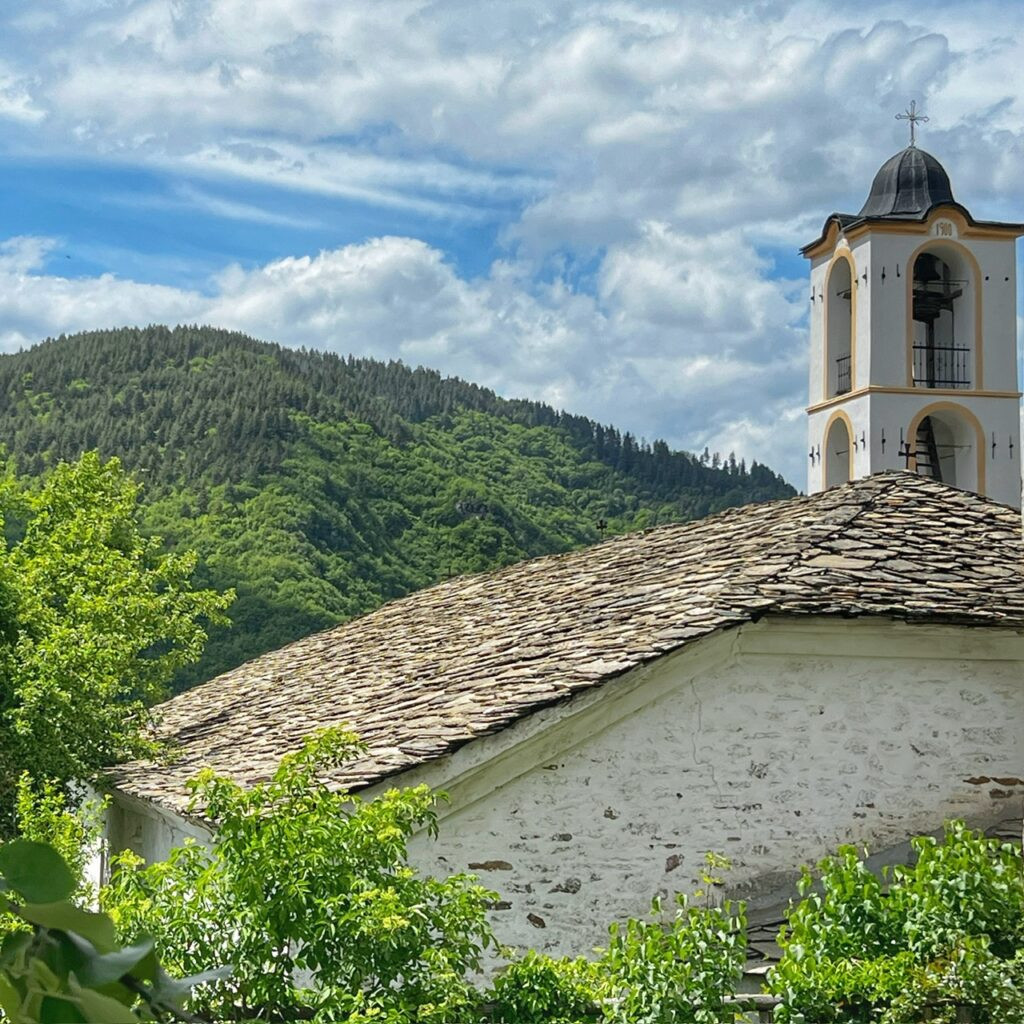
This included its National Revival Period during the 18th and 19th Centuries when it flourished in the craftsmanship you see today, and masonry.
Amongst one of the notable features of these villages is its roofs resembling fish-scales, made with a stone slabber clearly excellent in geometry. The tiles are known as “tikli” with a medium-sized house bearing a weight of about 25 tons. In order to hold this extraordinary weight, strong walls and beams were used, along with a lot of mud. Thanks to the use of mud, everything stays in place and hasn’t moved in centuries-all without mortar, cement and concrete.
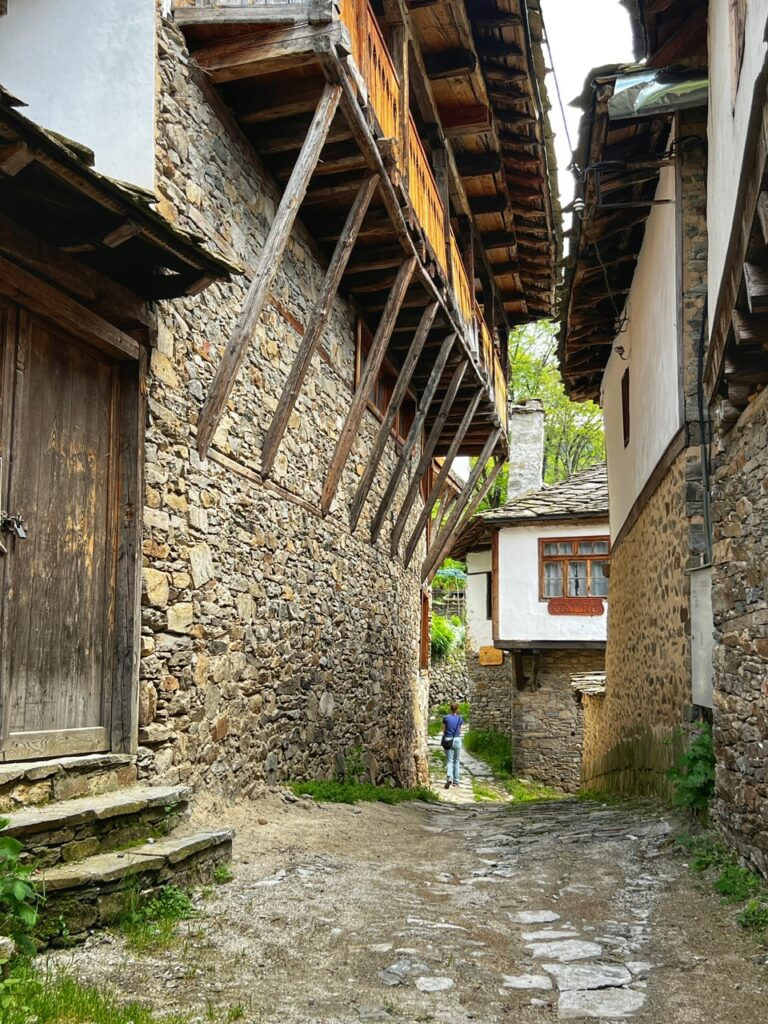
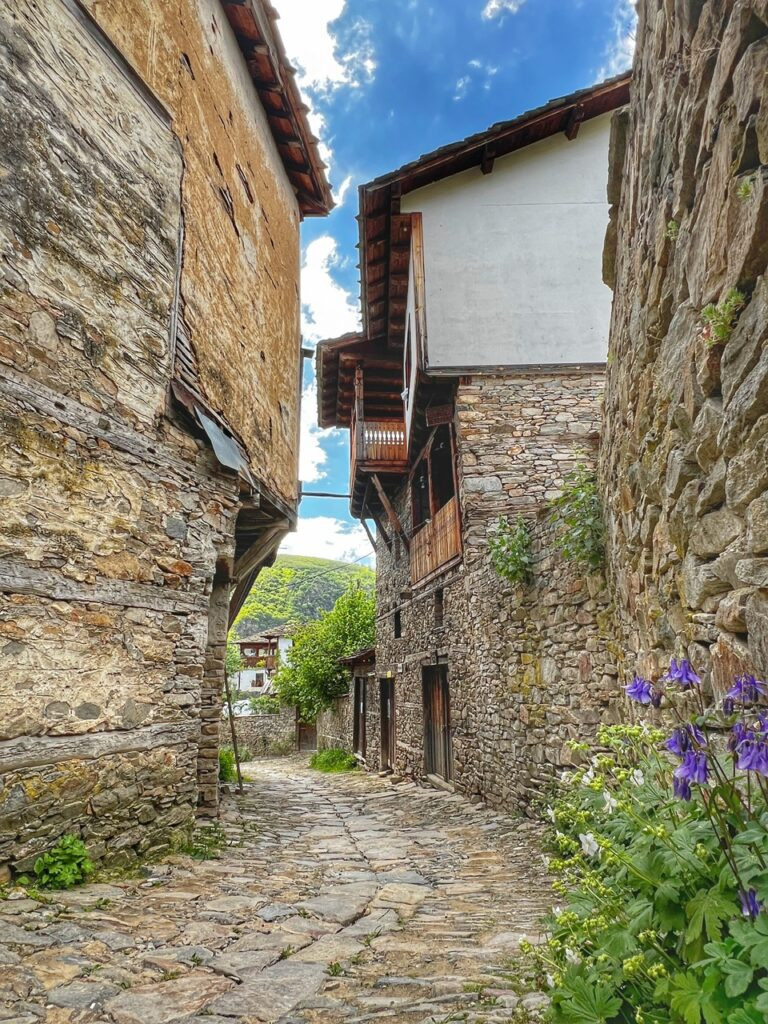
Wandering through these streets, it’s also easy to see why Kovachevitsa is frequently used as a film set for Bulgarian historical dramas.
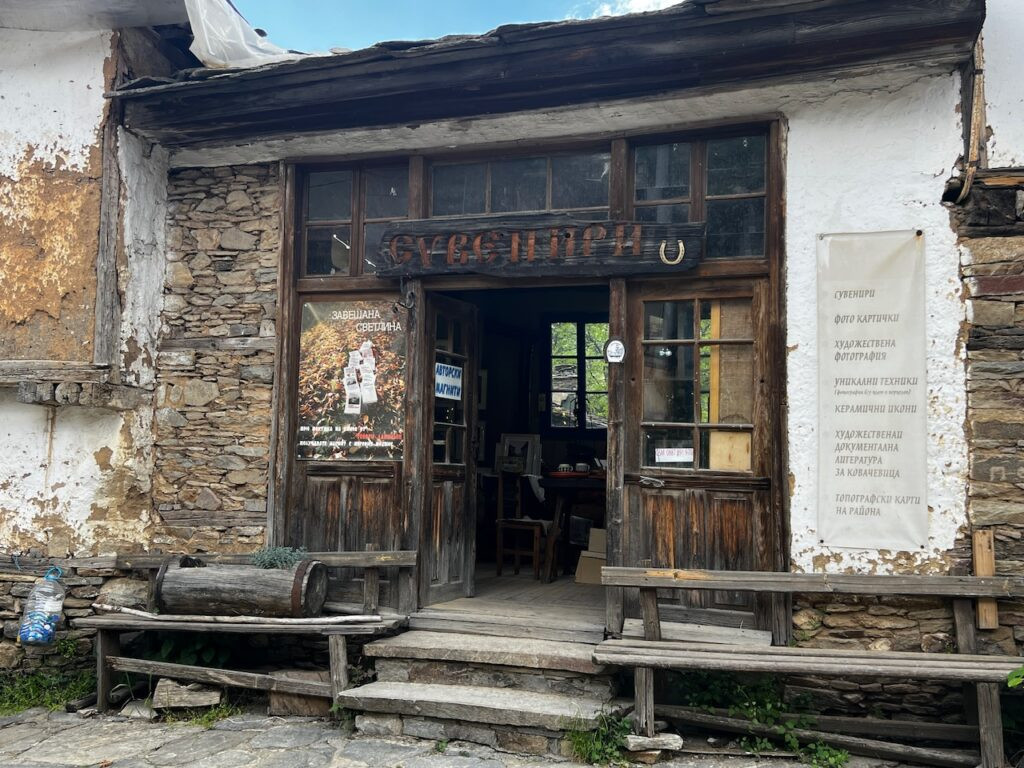
There is little to find in terms of commercial pursuits, although there are a couple ресторант (restaurants) that are mixed in perfectly with the scene…
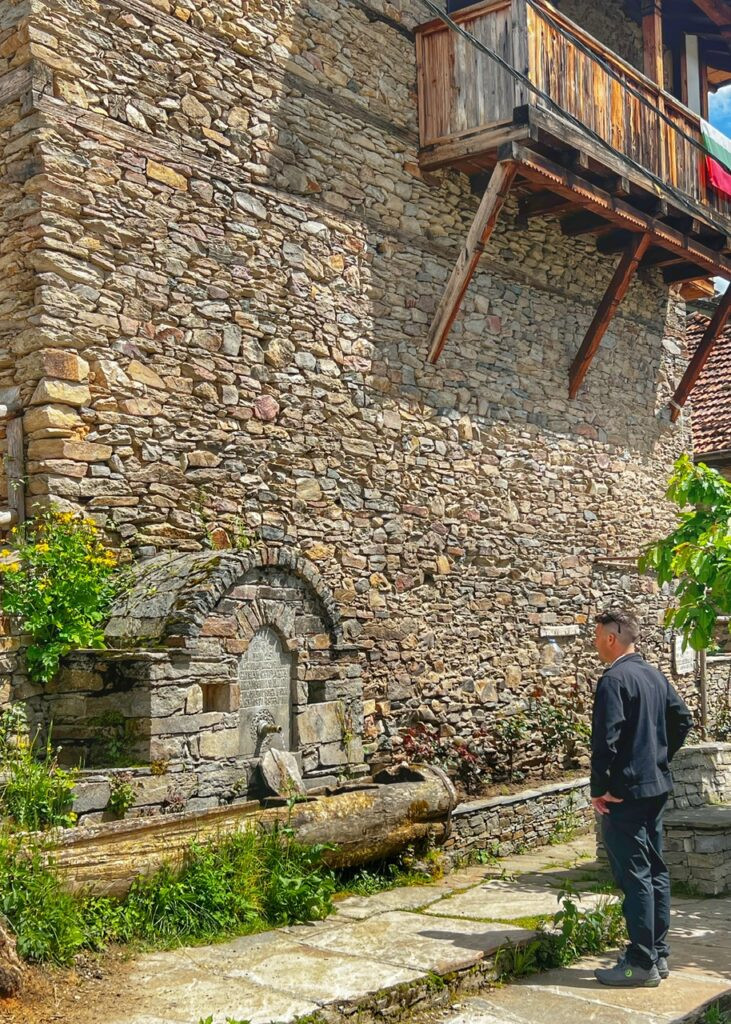
…and as always, lots of places to fill your water bottle, as Greg admires the craftsmanship of this massive stone wall, and wooden fixtures.
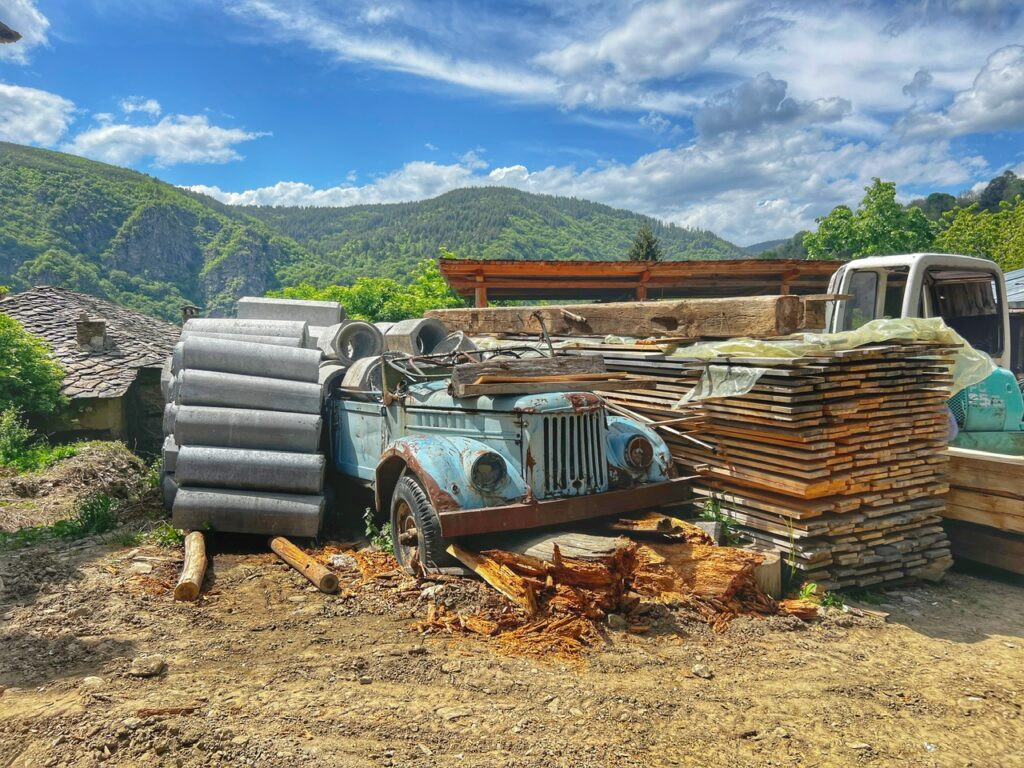
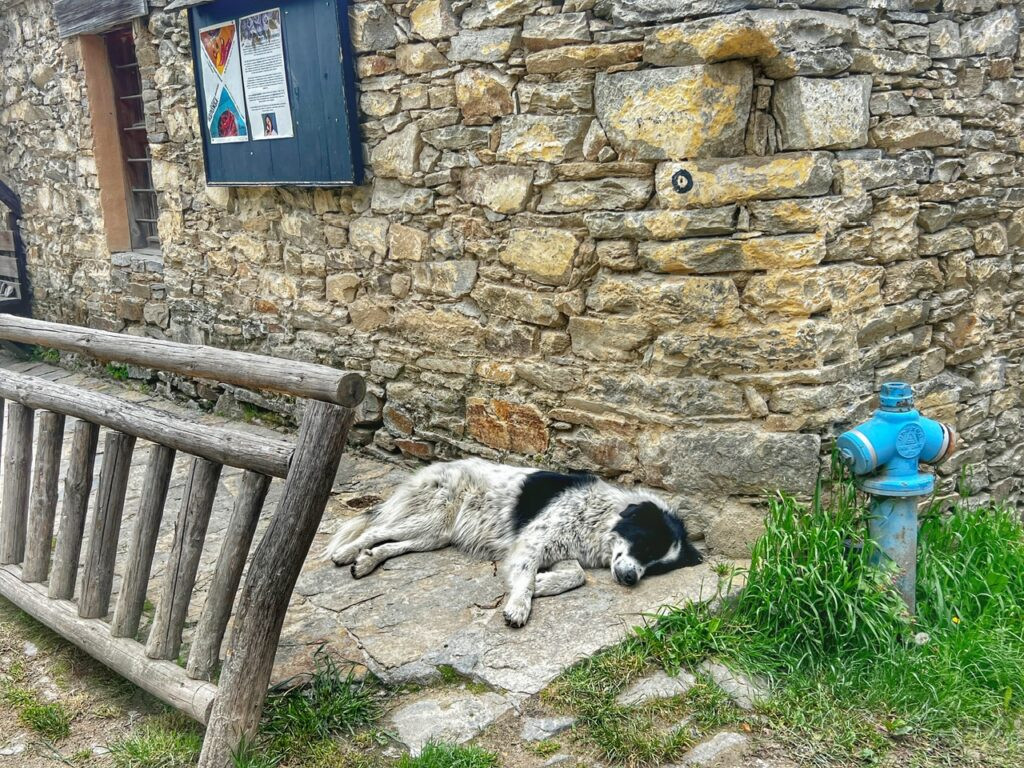
The nice thing about Kovachevitsa is they are also actively renovating and rebuilding, as evidenced by this pile of materials which uses the skeleton of an old car as its placeholder.
Strangely, we didn’t find many felines in this village, though a few big Balkan dogs pooled at the feet of various stone walls. Fortunately, they are usually friendly, and we’ve discovered, they too like cat treats. 🤣
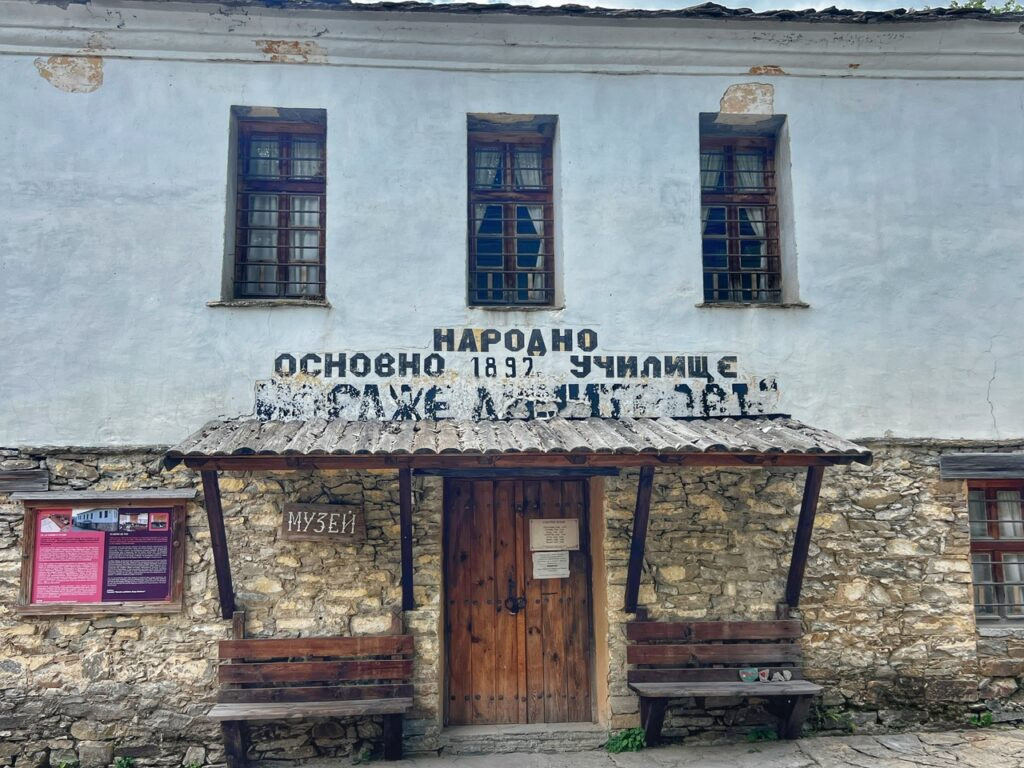
The local school, which was built in 1830, is notable as a symbol of Bulgarian resilience and national identity as a pre-Liberation-era school under Ottoman rule. This was a bold move in an era when Christian Bulgarians had limited access to education. Priests were the ones teaching children how to read and write using old church books and folk texts. That was all they could offer.

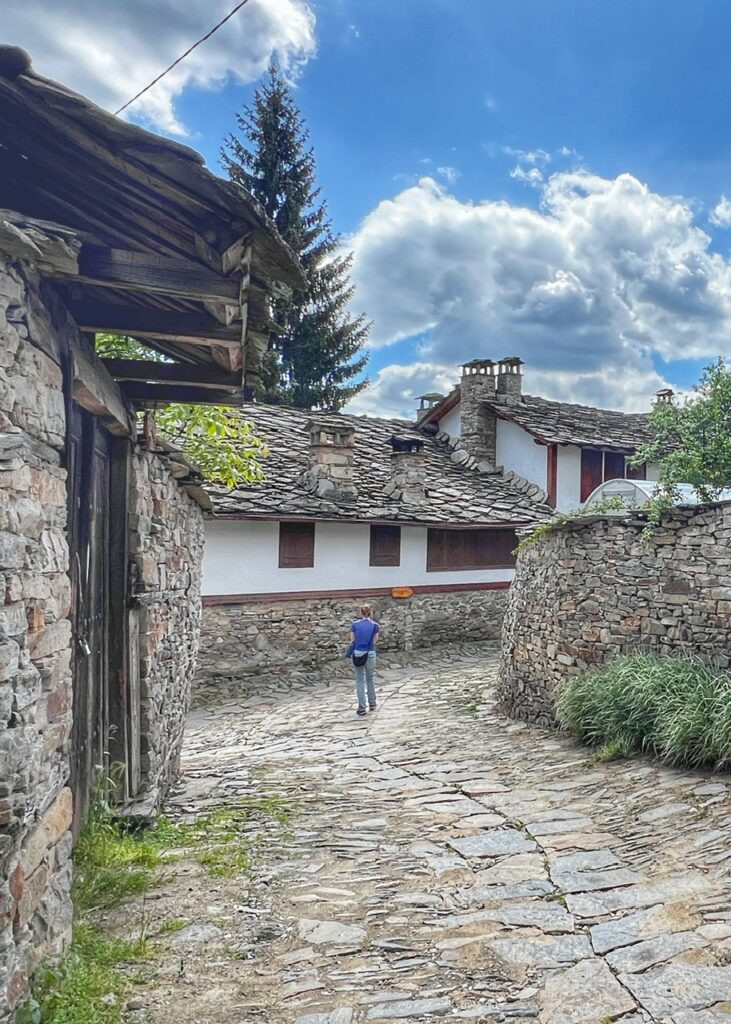
Seriously endless roaming potential…
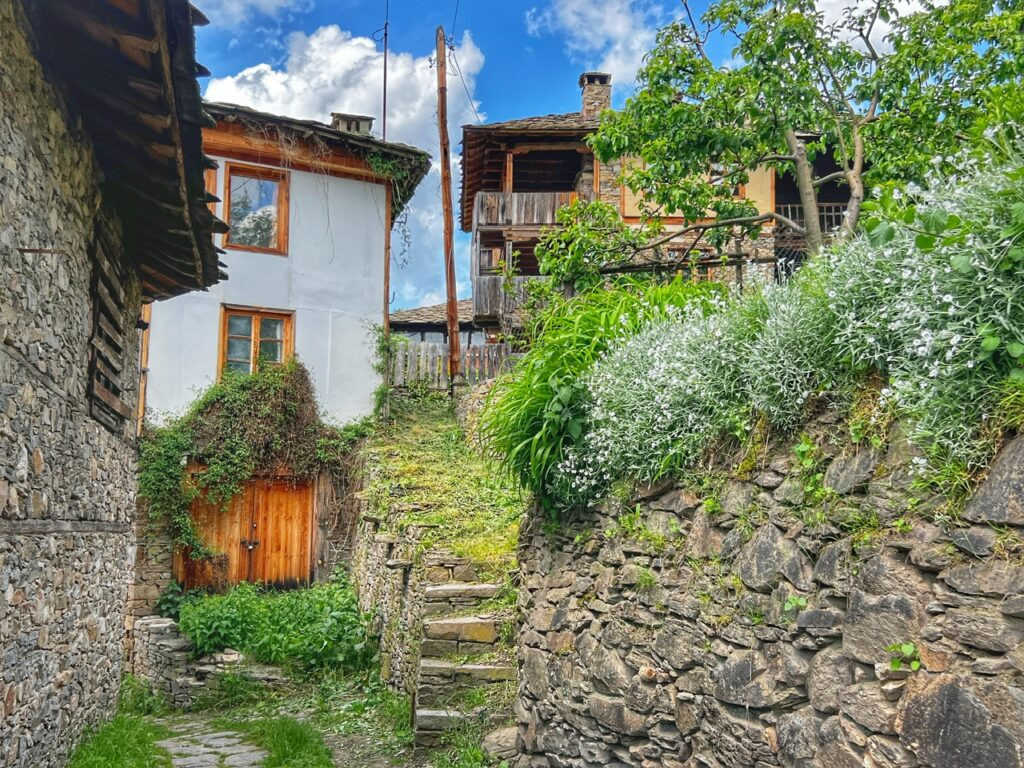
…around which stone staircases connected one level of the village to the next.
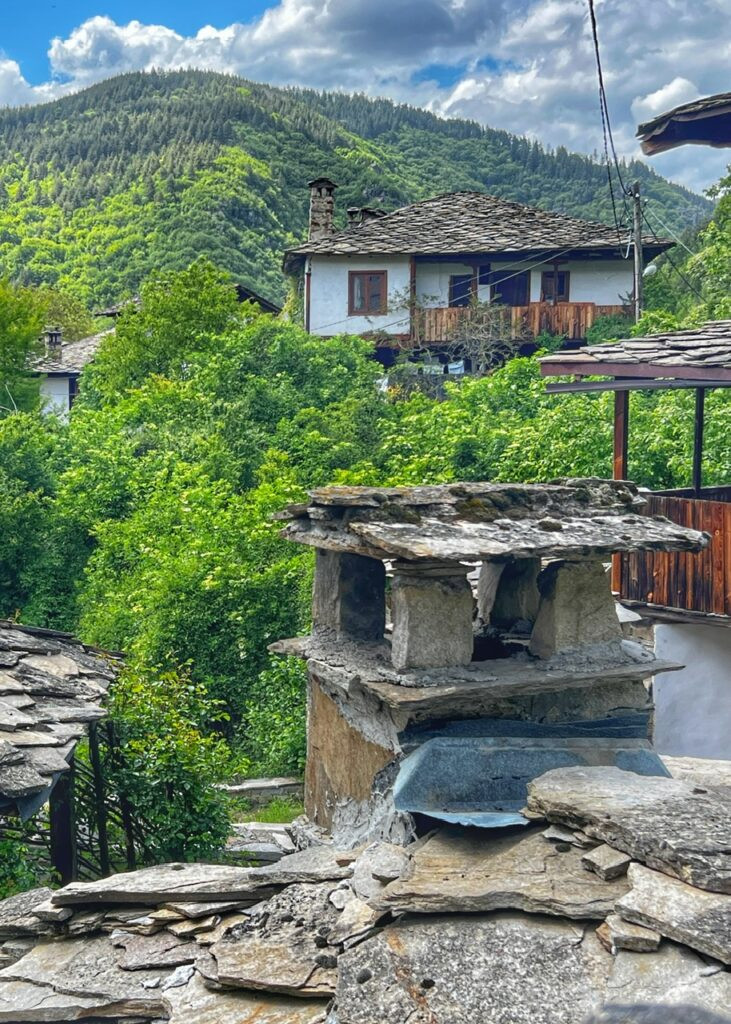
And don’t forget to drink in the intricacies of the chimneys!
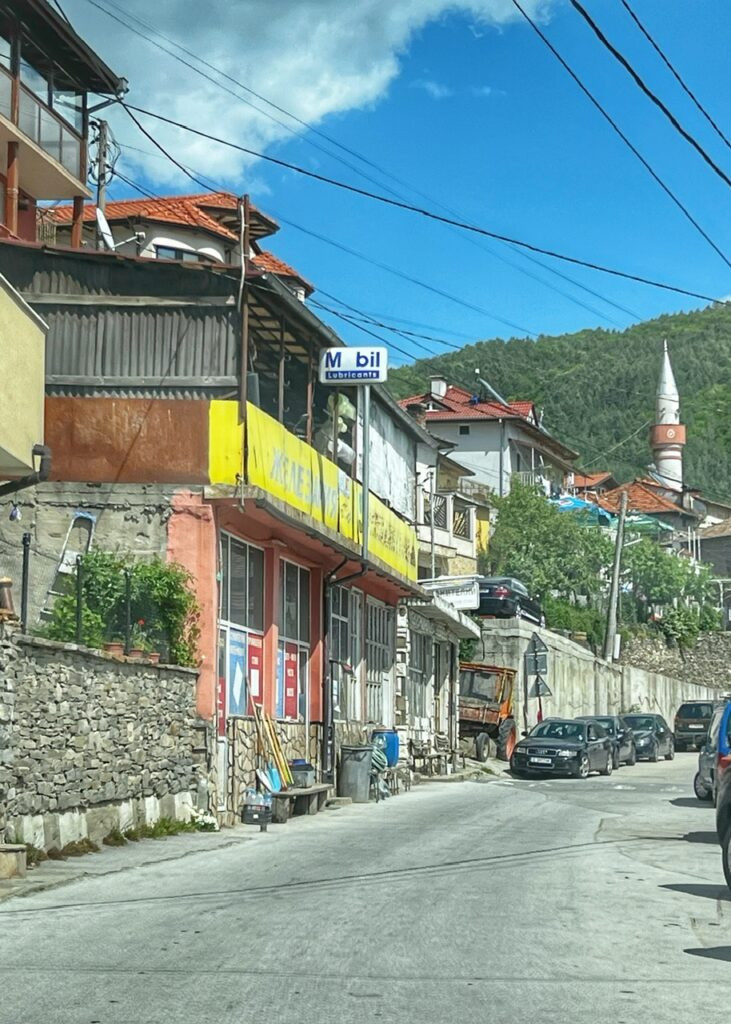
A 4.8 kilometer rumble down the steep and serpentine road, (still completely fine for a rental car,) we arrived to the much more functional and modern village of…
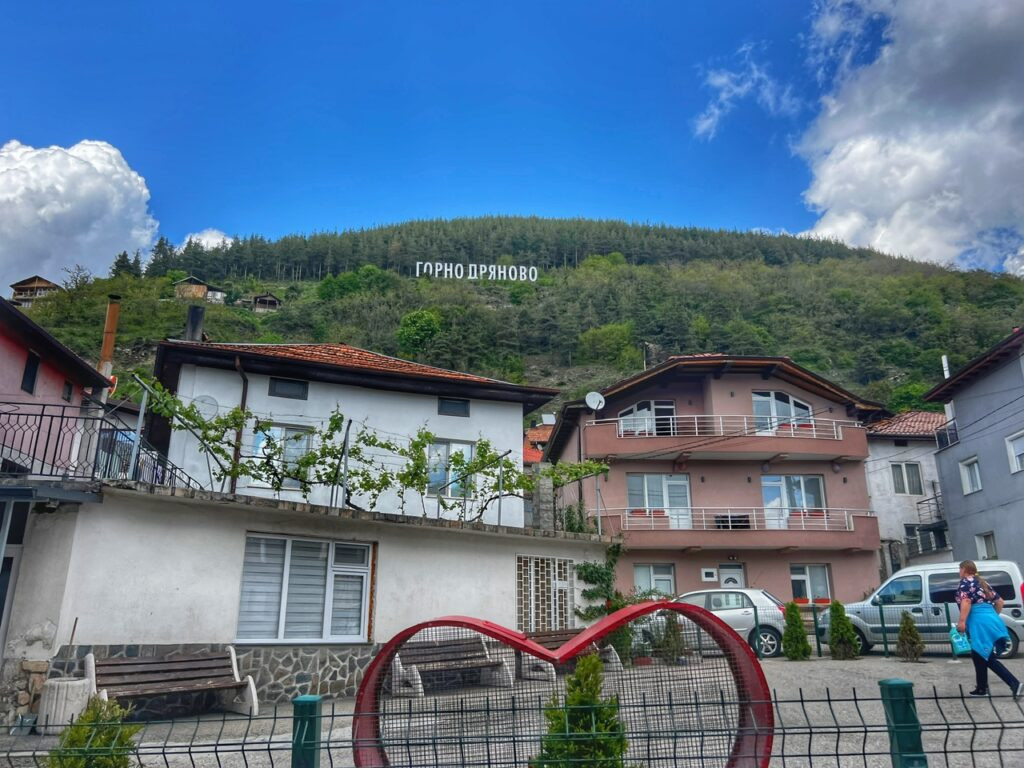
…Gorno Dryavno…which declared its name Hollywood style to remind all those movie producers passing through of its presence.
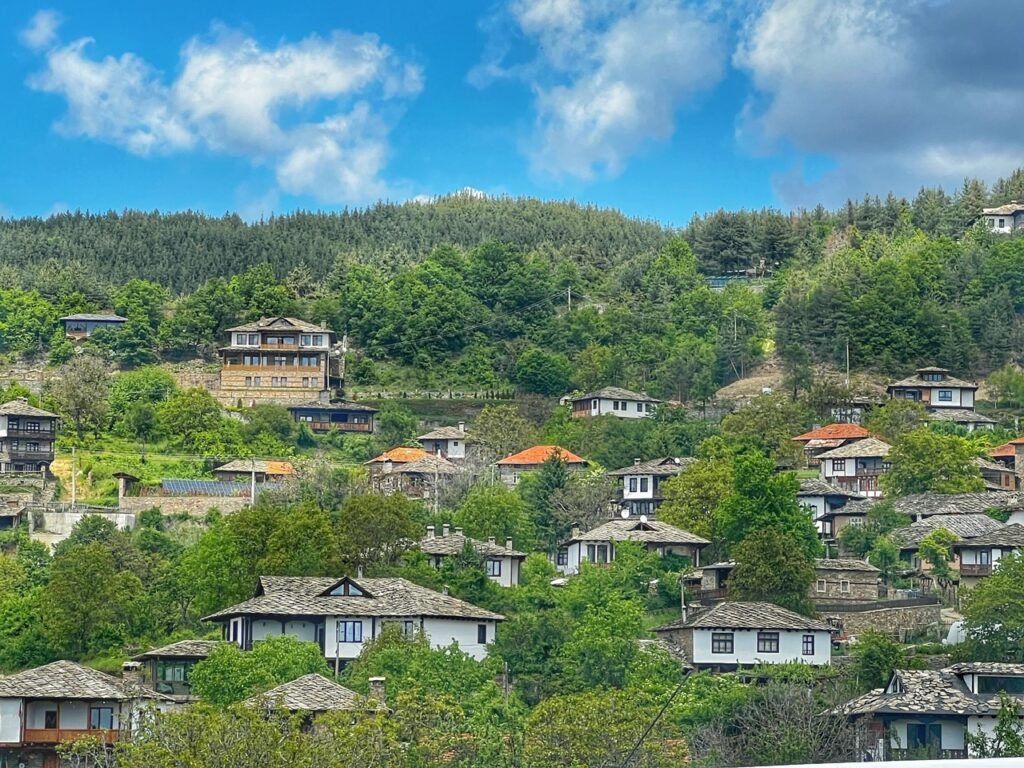
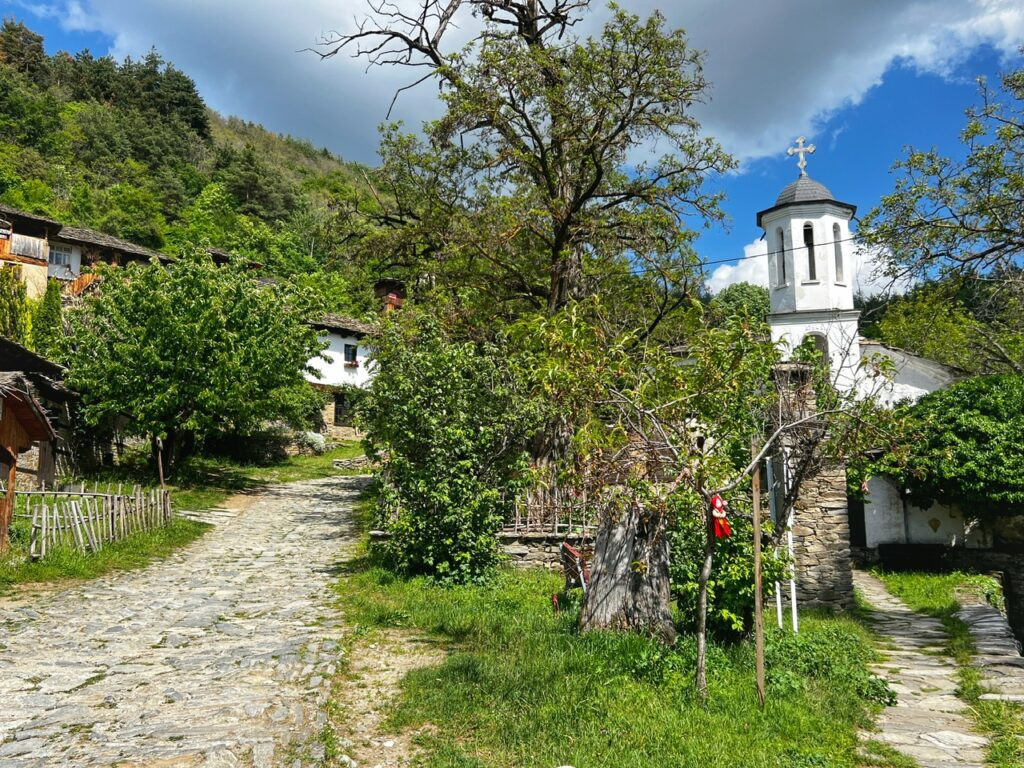
A few kilometers further down is Leshten, which shares its architectural demeanor with Kovachevitsa, although its a bit more compact.
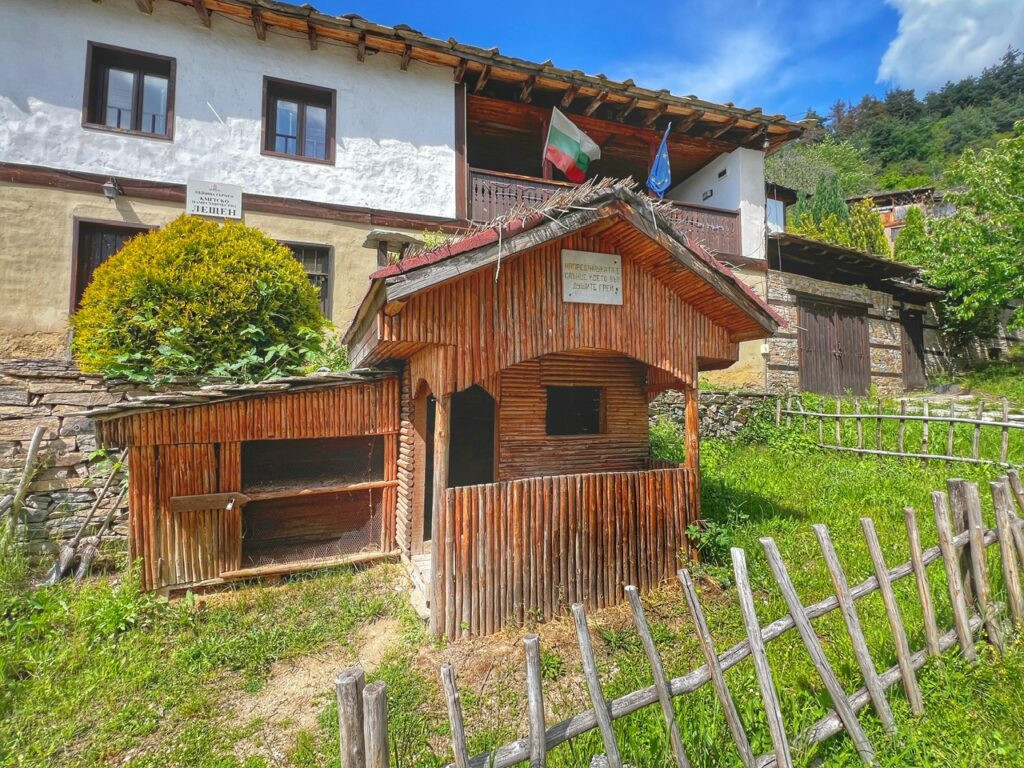
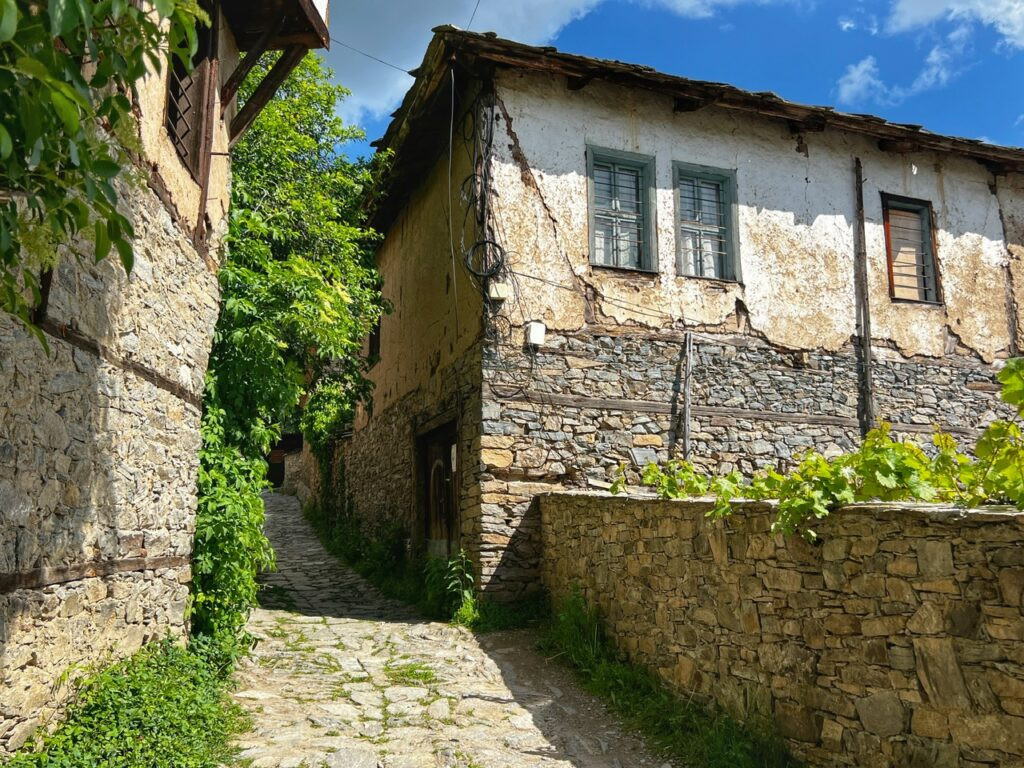
It also has what appears to be a very swanky chicken chalet with a welcoming EU and Bulgarian flag over the entrance and a sign that says, “Advanced science is the sun that brings out grey souls.” The chickens in Lesten are quite philosophical….We like it.
Leshten would have been a nice place to stay for the evening because there were a lot of guesthouses…next time. 🤣
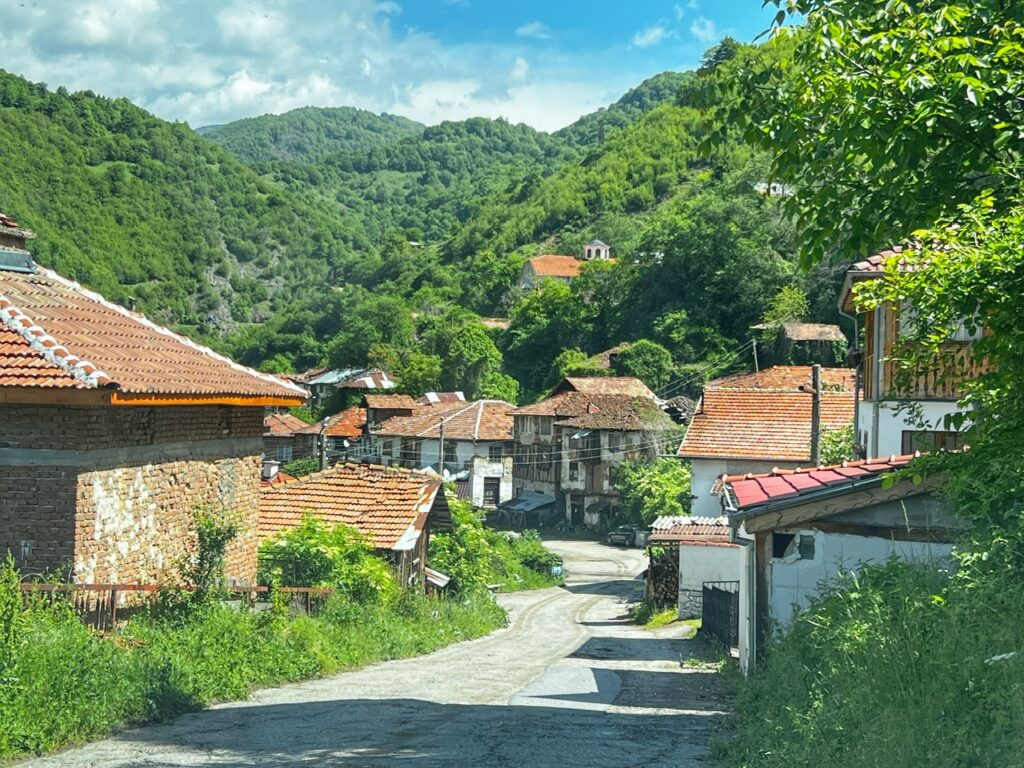
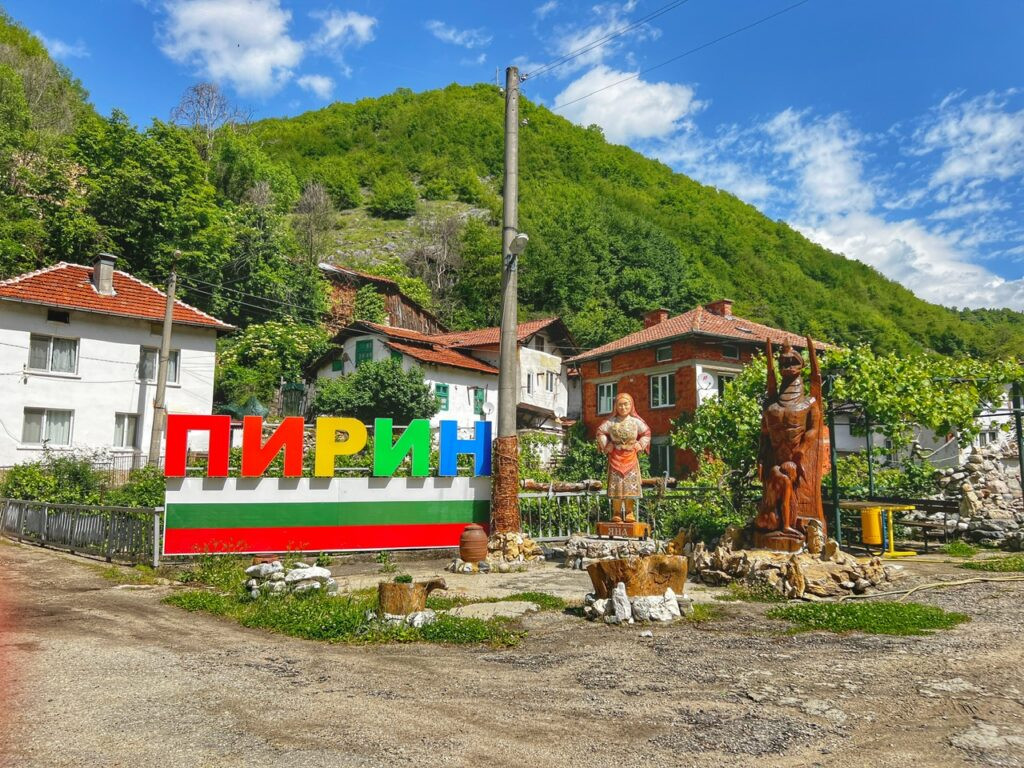
Another place we stopped on day one was the namesake town of Pirin, where we got eyed by the village people like Mandy eyeing Greg slinking near the sweets before dinner.
Bizarrely, even in this high mountain village, it had a rainbow Instagram sign, dropped alongside some other notable village people….the Gincho Dragon and Kallina Maiden, in reference to the legend of a scary dragon who fell in love with the beautiful maiden Kallina from the Gincho clan. Sounds like the Beauty and The Beast of the East. (Europe that is.)
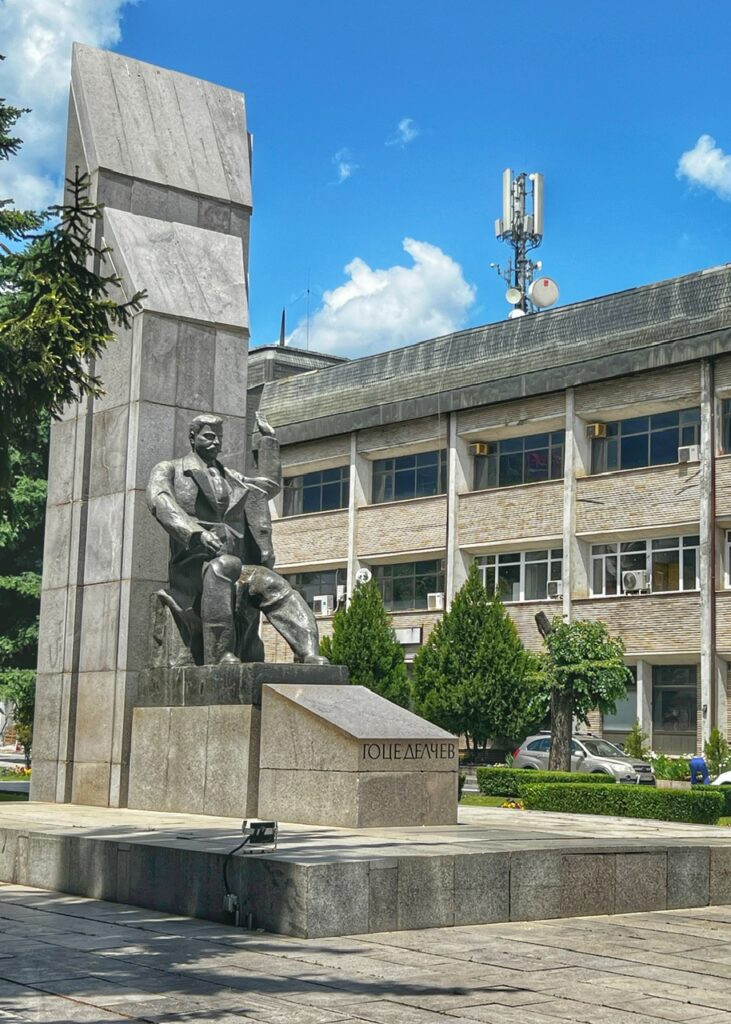
We also included a stop in the 18,000 person metropolis of Gotse Delchev, named after a Bulgarian revolutionary who was a national hero in the struggle against Ottoman rule. Apparently, Mr. Delchev was quite stocky…and blocky.
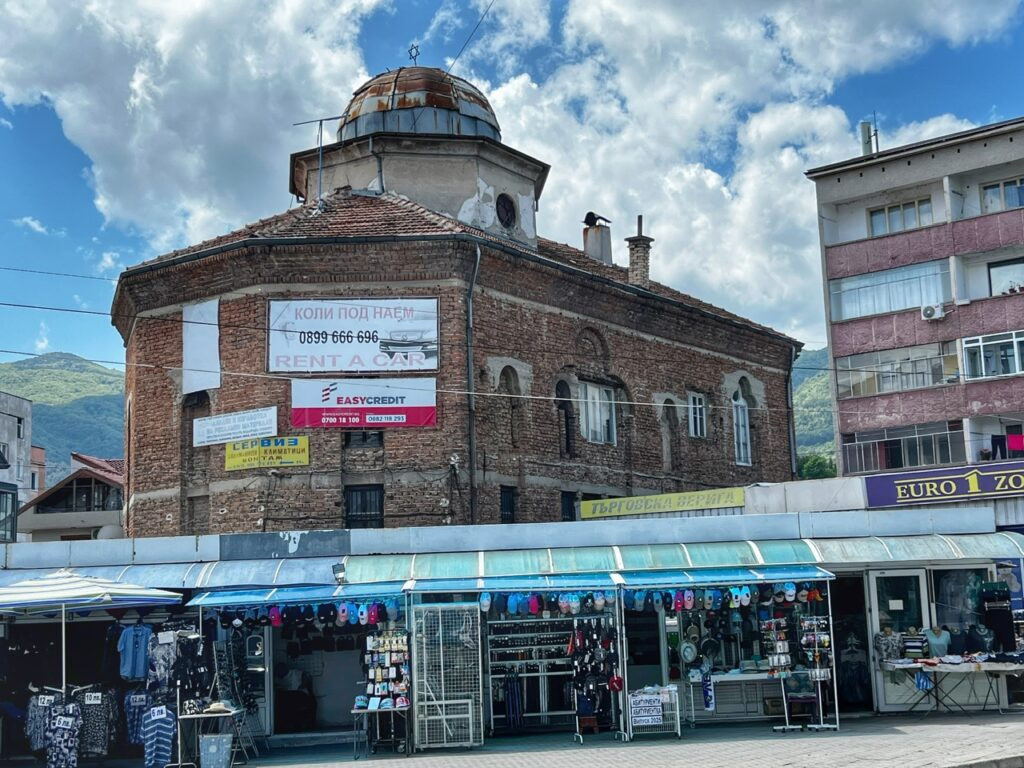
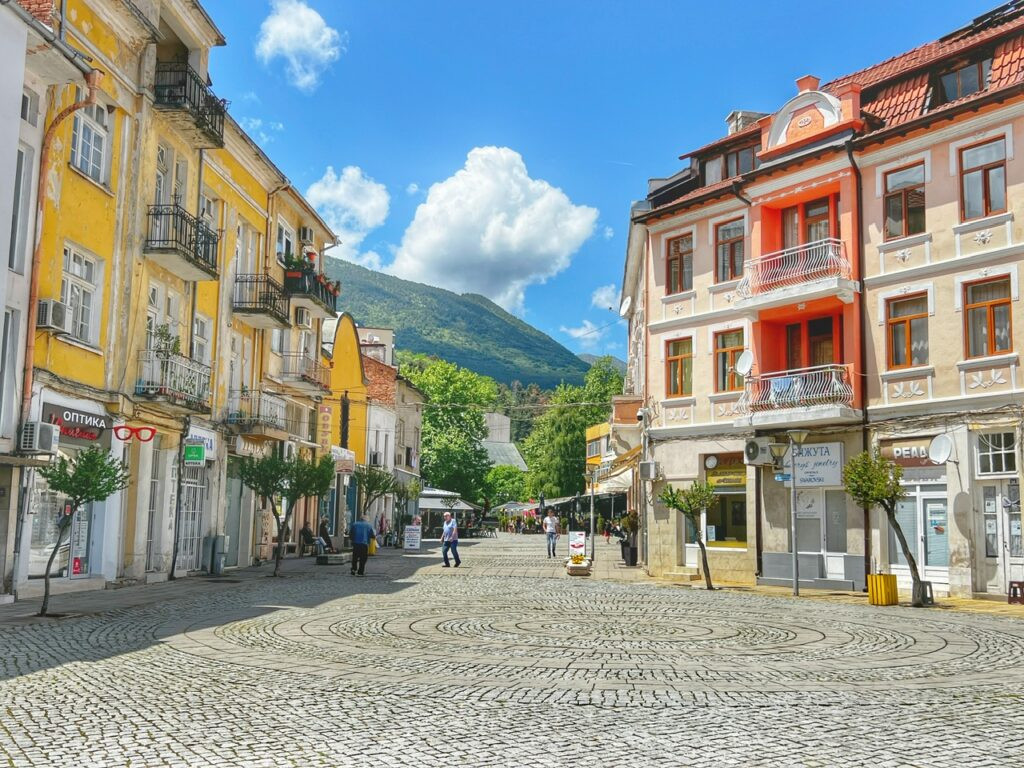
They had a lively market area, curiously surrounding a synagogue, and it was pleasantly walkable.
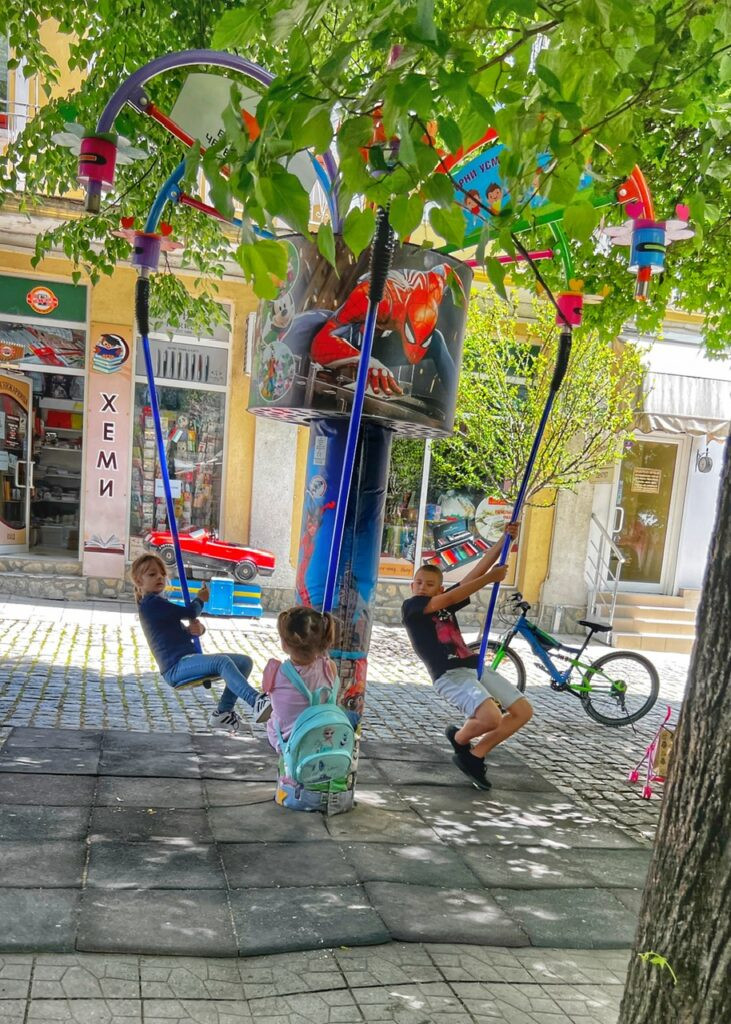
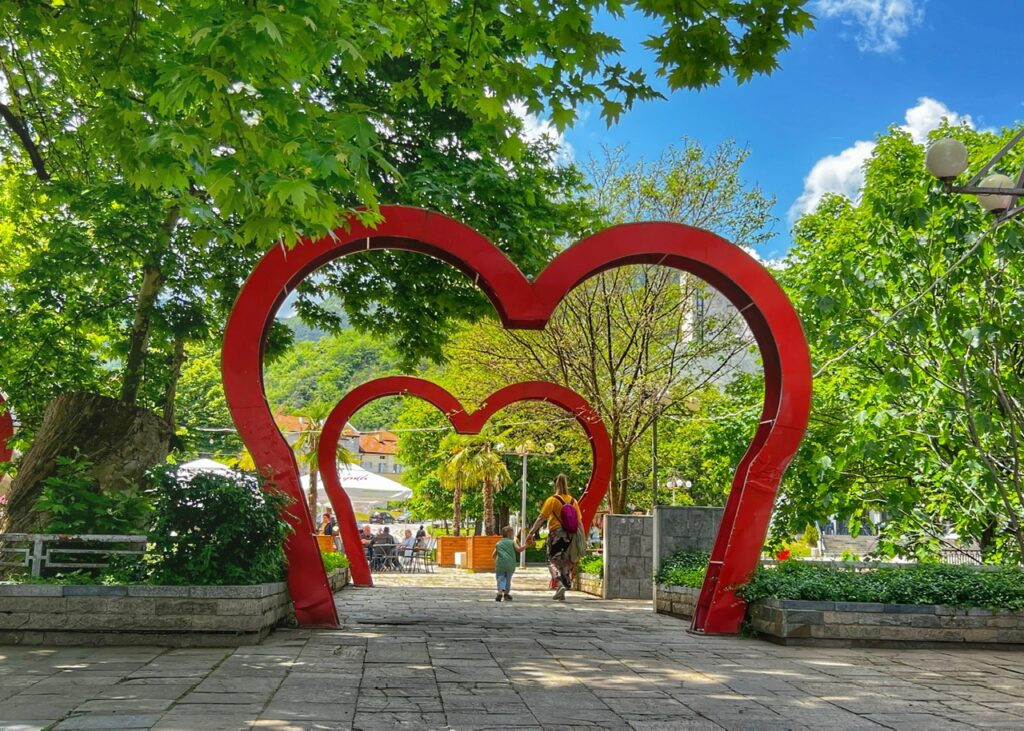
The kids in Bulgaria love these bouncing, swing rides, which seem to be sponsored by the Red Cross. Hey look! Bulgaria meets hokey Vietnam!!
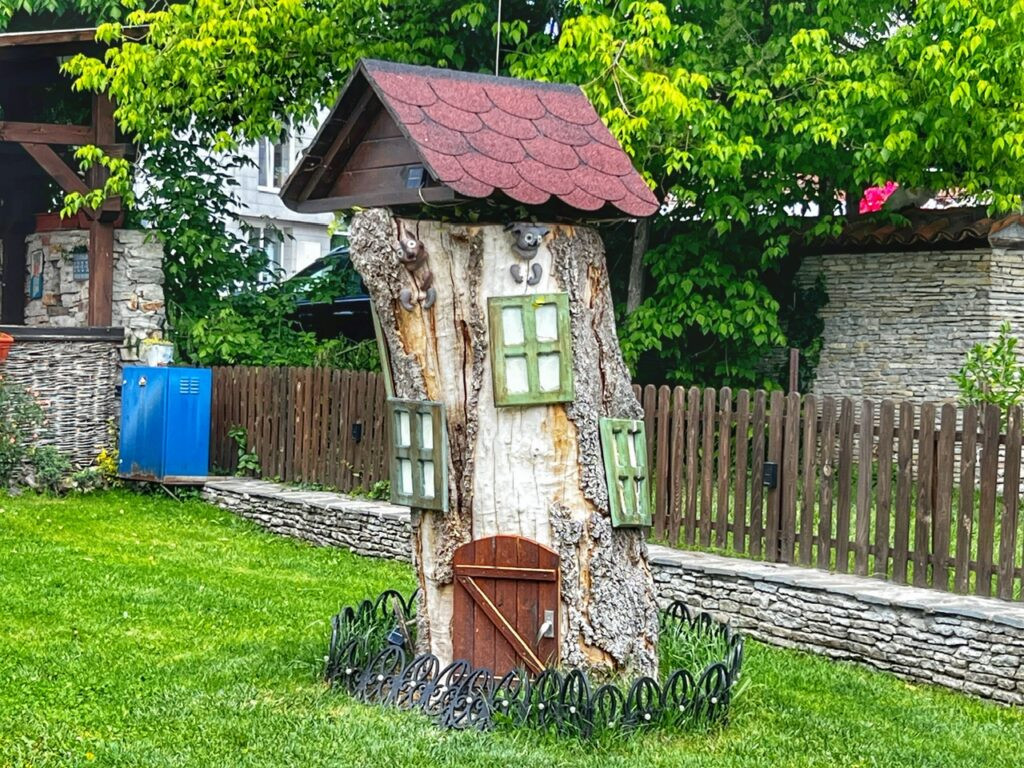
What is lacks in heart archway kitsch, it redeems itself by turning tree stumps into elf abodes.
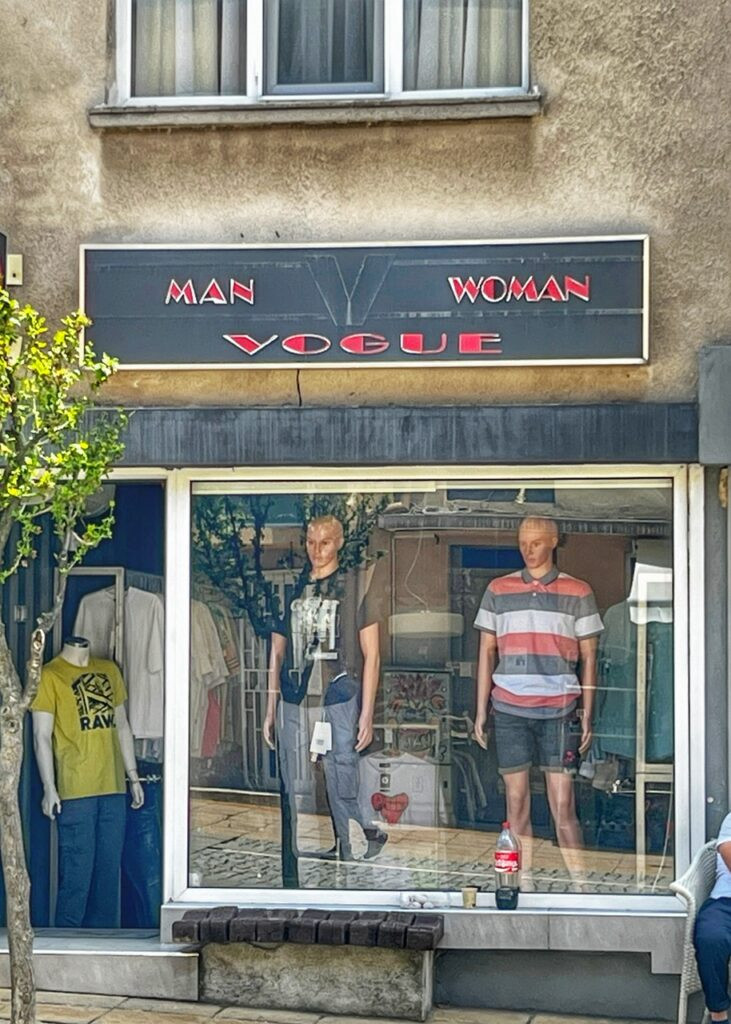
But…no one ever said that Bulgaria won any high fashion awards.
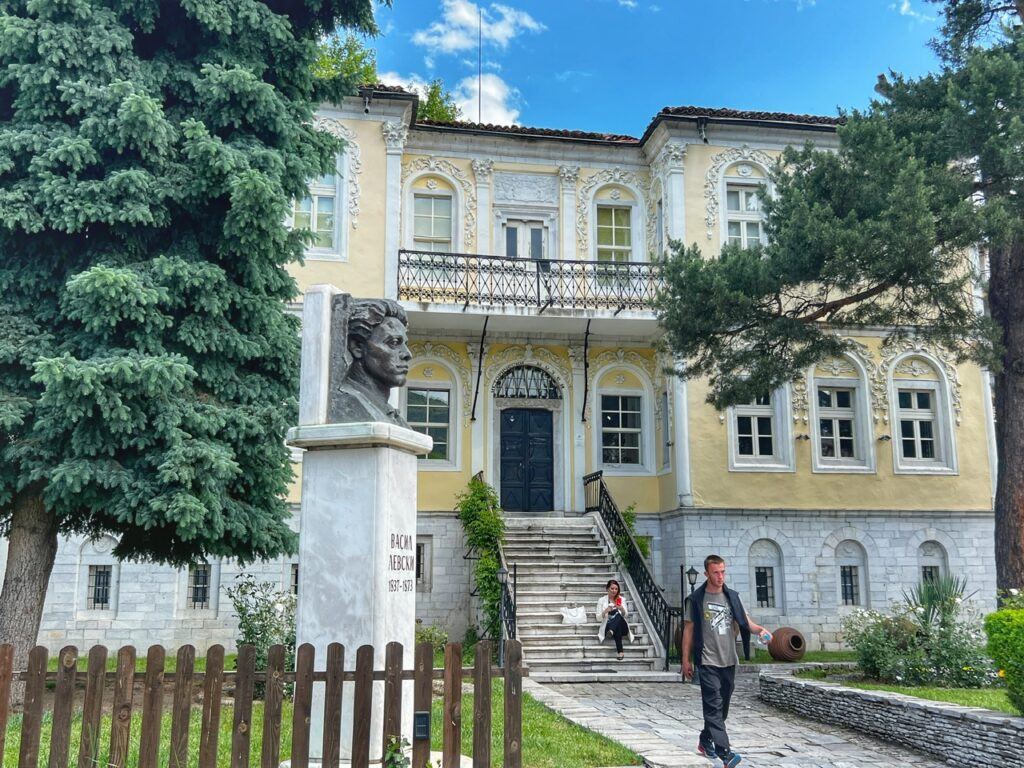
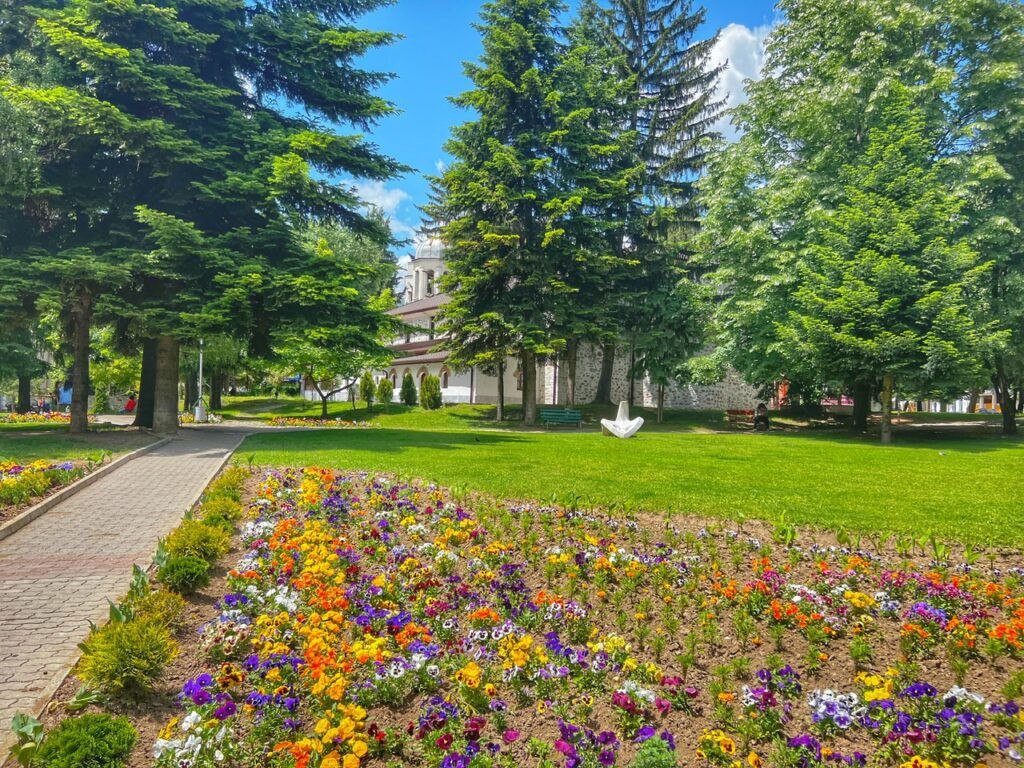
The Municipal History Museum in Gotse Delchev. They also had some really beautiful parks, like most Bulgarian cities.
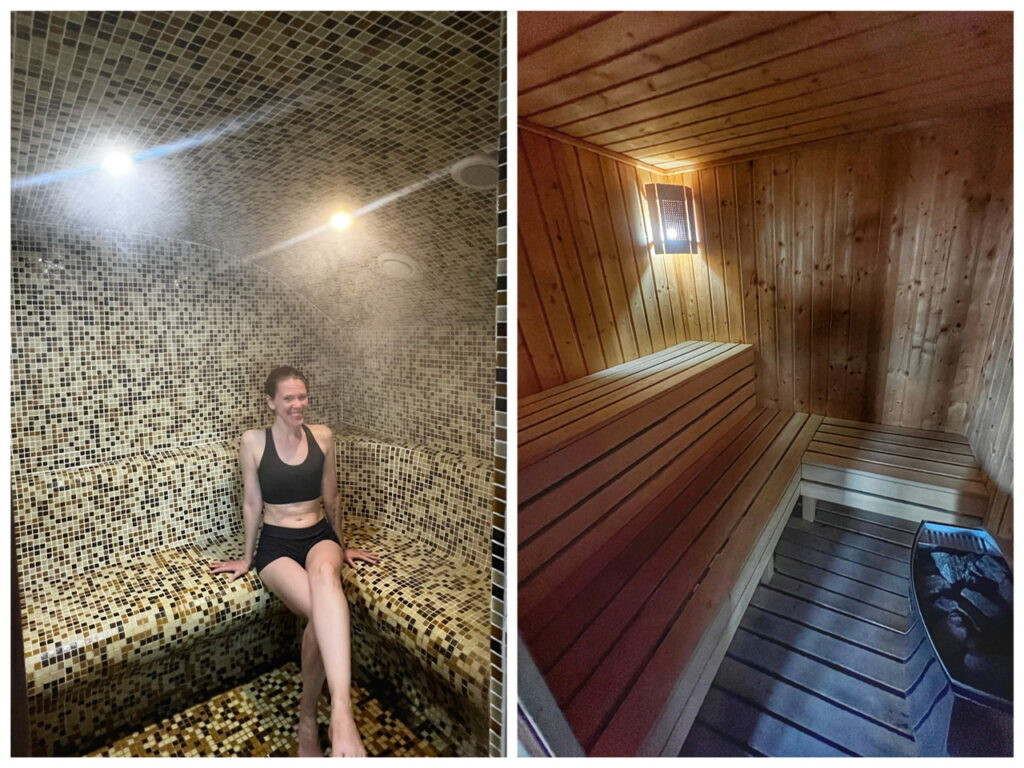
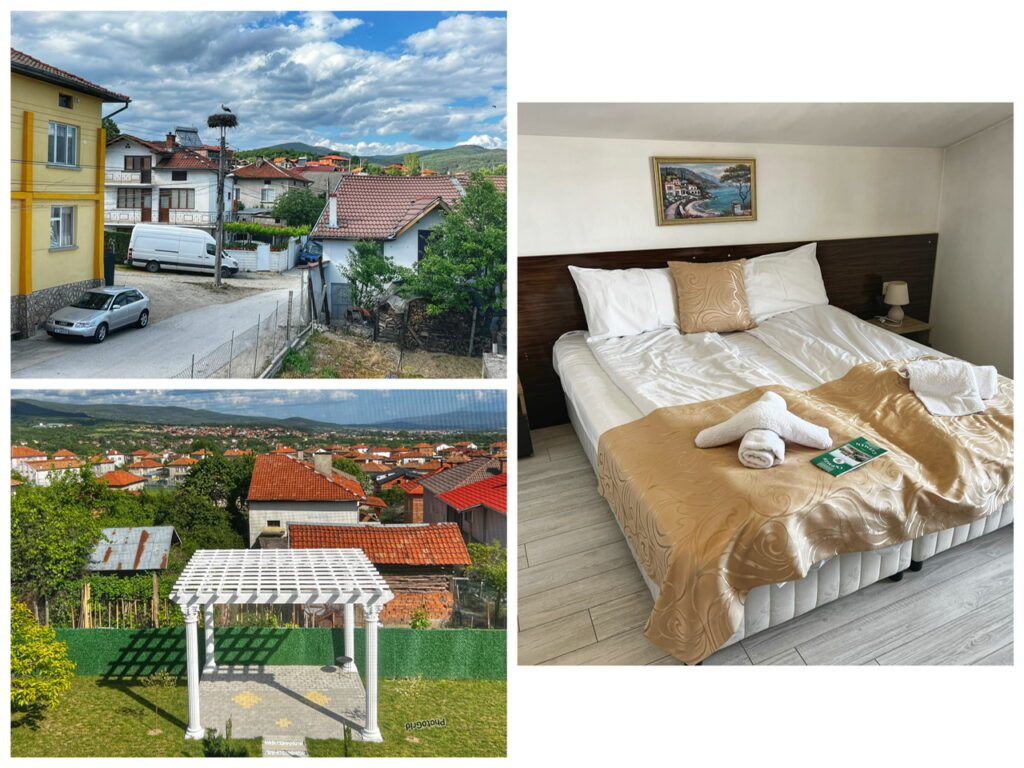
During the evening, we made our way to Ognyanovo, which is known for mineral baths, although we just took advantage of the steam and sauna provided by our guesthouse.
Other than the amenities, our guesthouse overlooking Ognyanovo was nothing too special and cost far more than you’d think at $37. They also must do weddings at that gaudy altar down there.
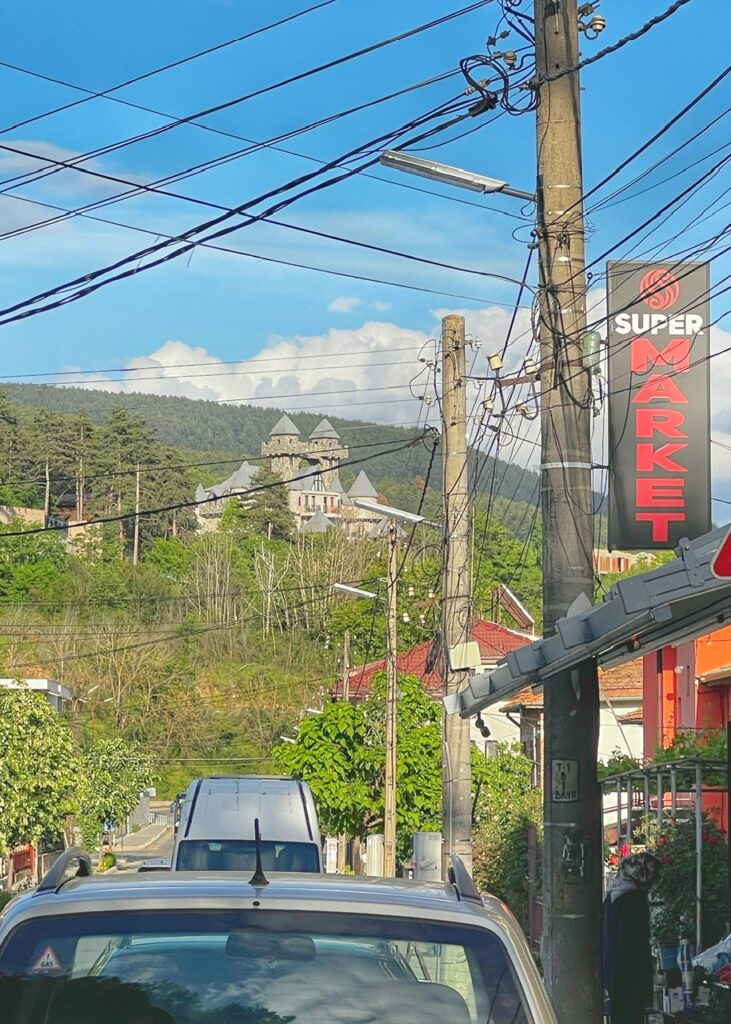
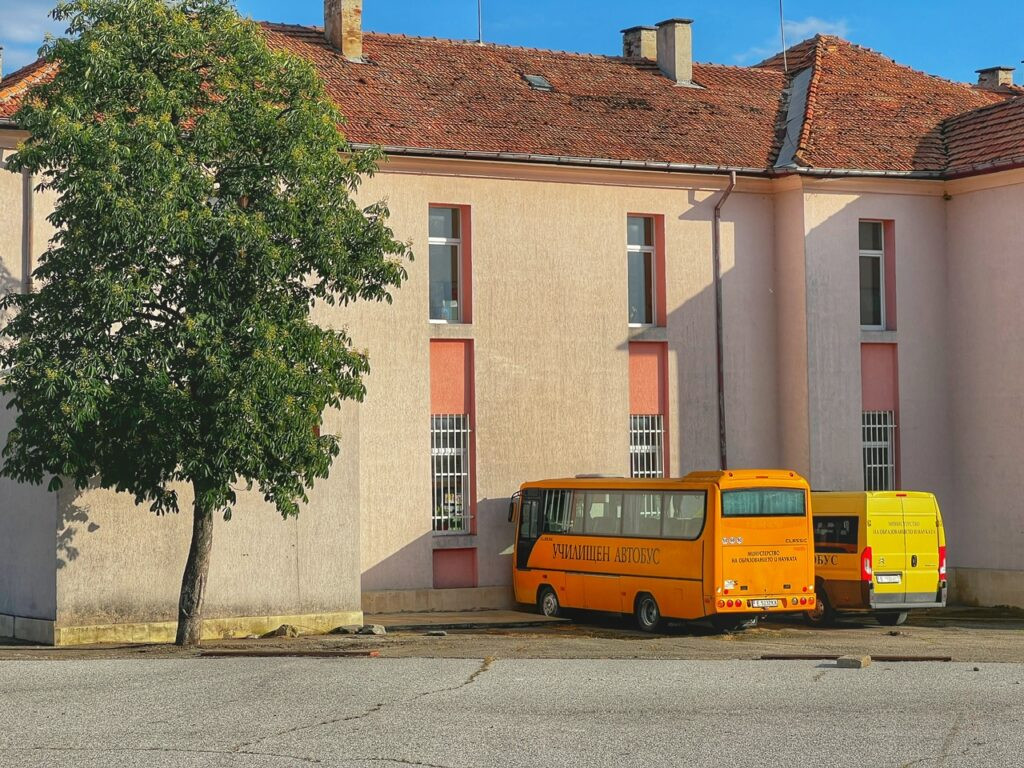
Another gaudy thing was the castle on the hill, which was a spa hotel. Seriously. Are we in Vietnam? Bulgarian school buses.
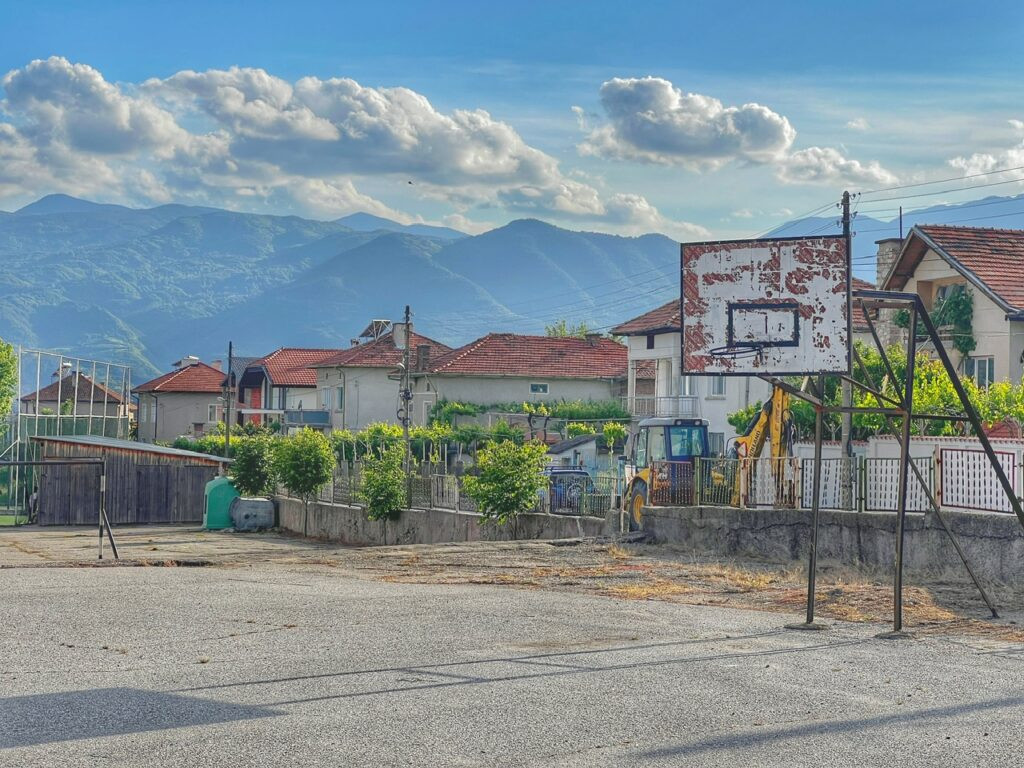
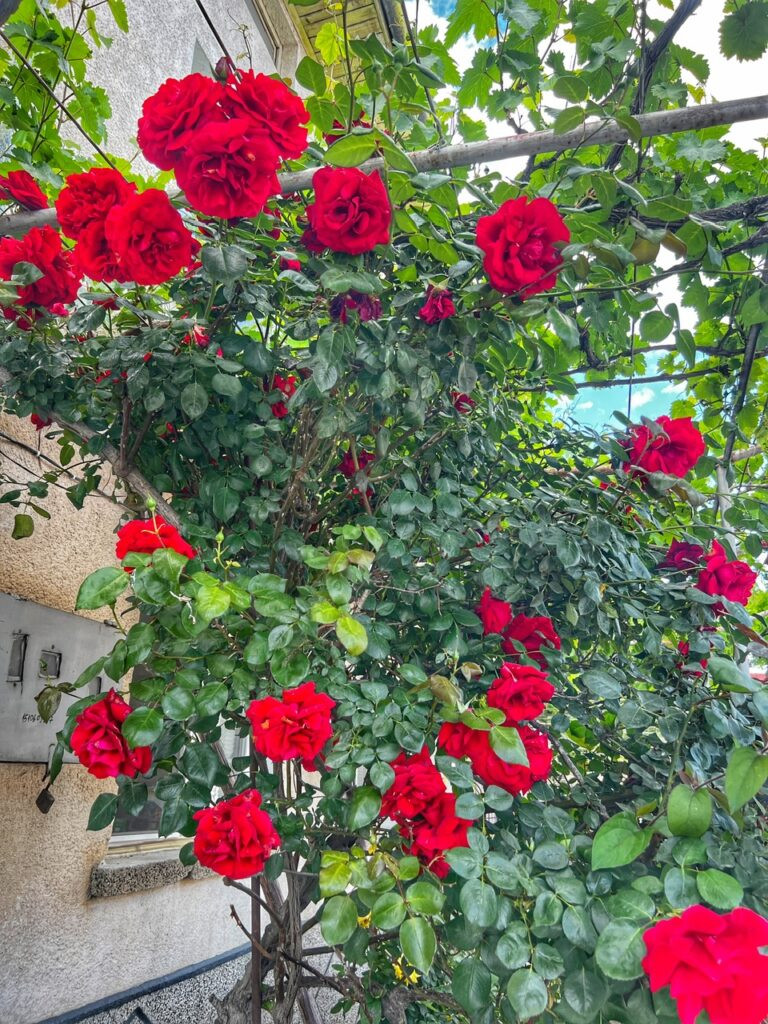
It was a quiet and lovely community otherwise, in which everyone’s roses were bursting.
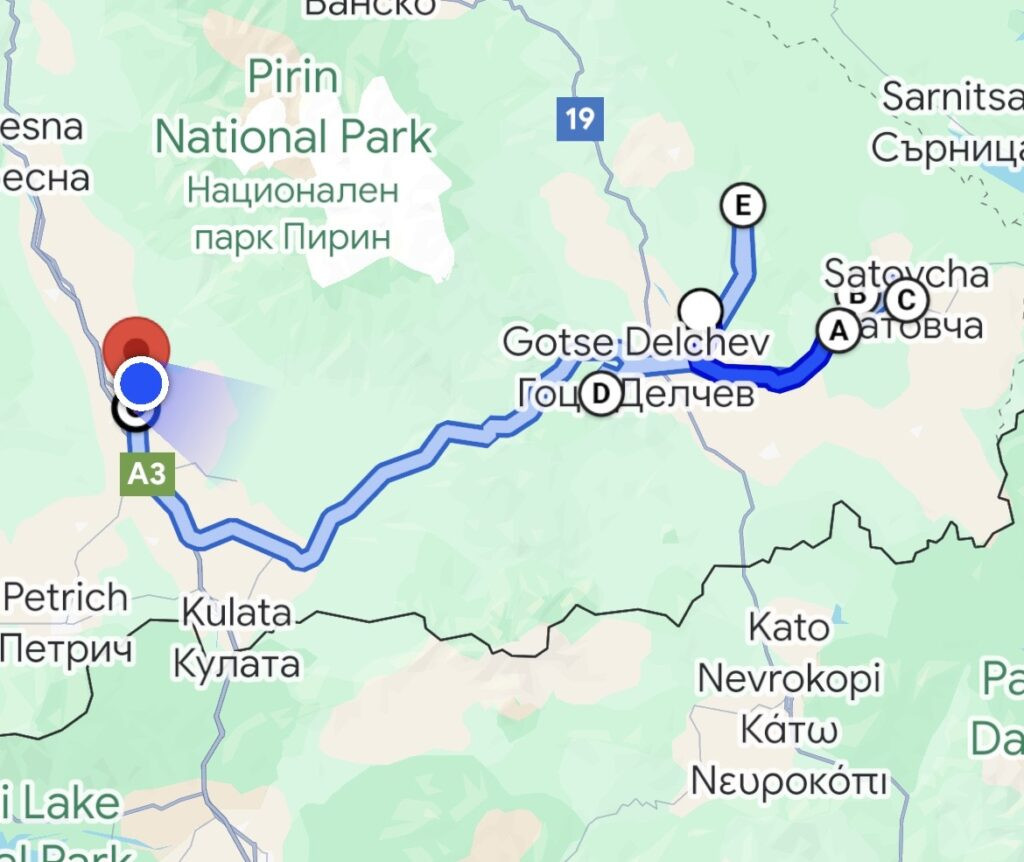
Our road trip route.
Day Two: Dolen, Delchevo, Satovcha, & Vinogradi
Day two of our road trip around SW Bulgaria’s Gotse Delchev got us onto a quite fun, yet steep trail at Gradishte Landscape Park where we constantly felt we were being watched, into another architecturally adorable Thracian-rooted village in Dolen where we met some new local friends, and we also barreled up the winding mountain to the picturesqued perch of Delchevo.
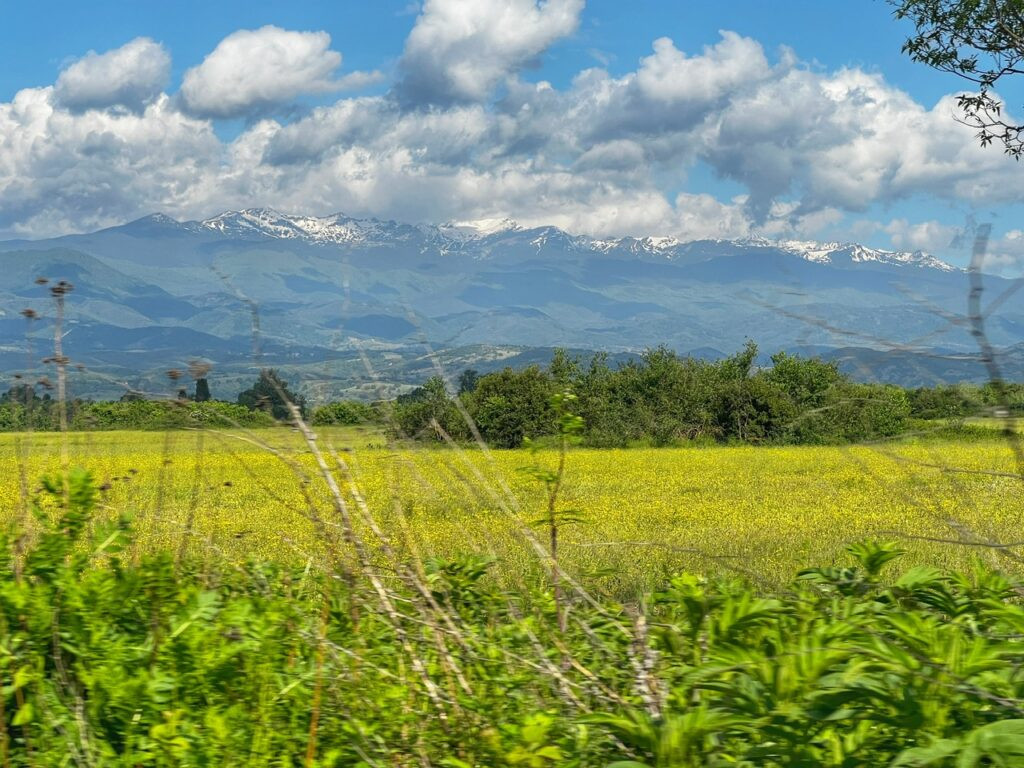
A constant friend and beautiful presence throughout this leg of the journey was the snow-capped Pirin Mountains.
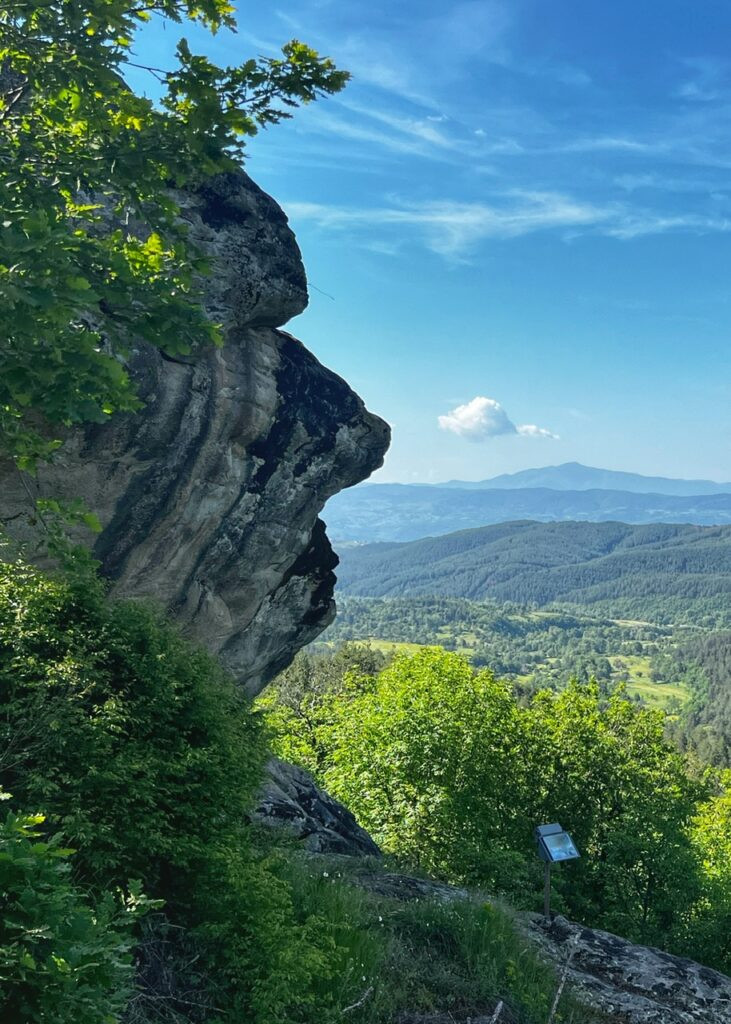
Arriving to Gradishte Historic Landscape, which offers trails with panoramic views, notable for unique rock formations like this contemplative and slavic-nosed mega head.
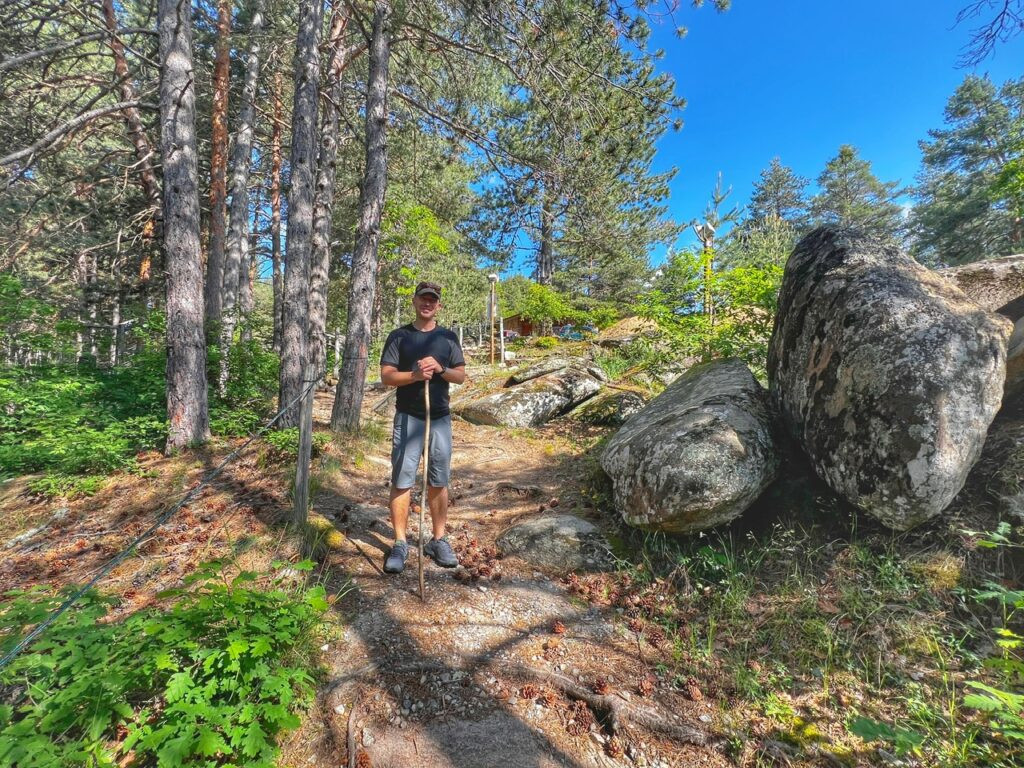
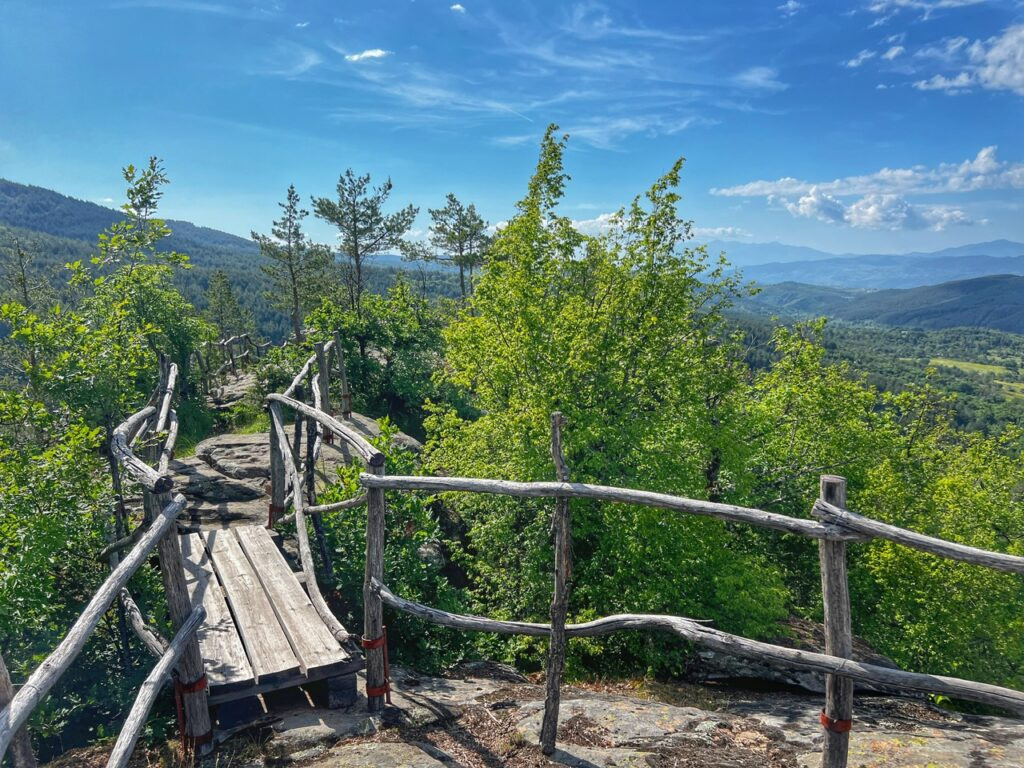
After grinning (and struggling) through a Bulgarian chat with the groundskeeper, the 4-km trail cost us about $2/ticket. But the walking stick he provided was free!
Little did we know, we would actually need this pole because after a lovely ridge walk with strategically-assembled sticks and boards…
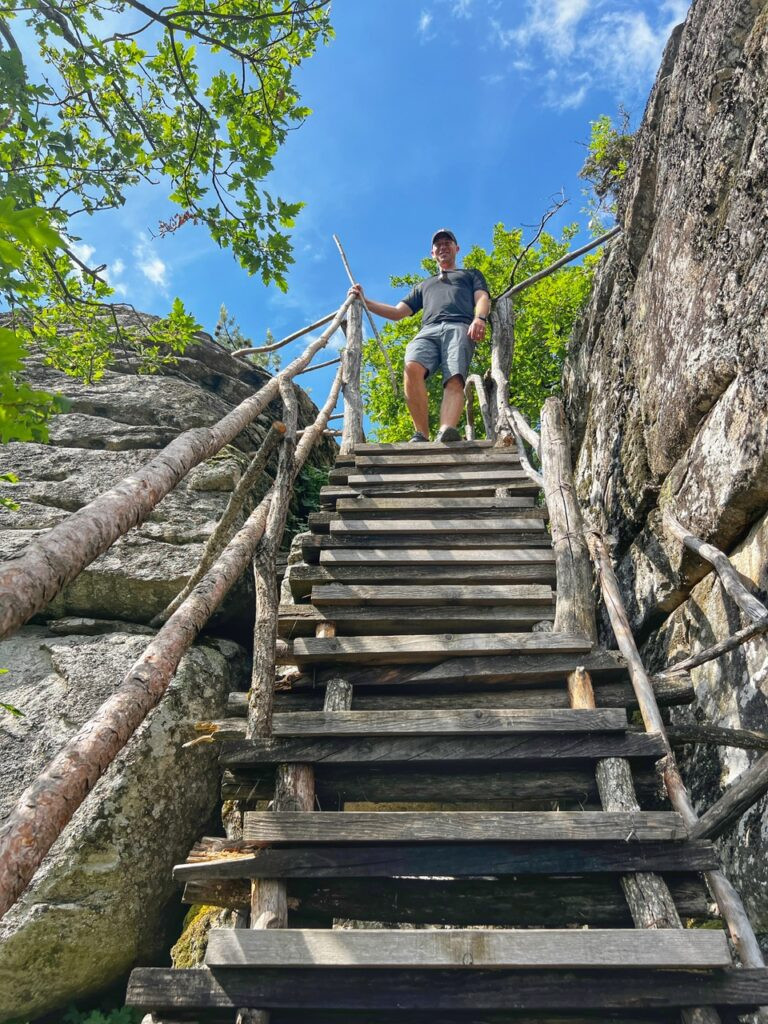
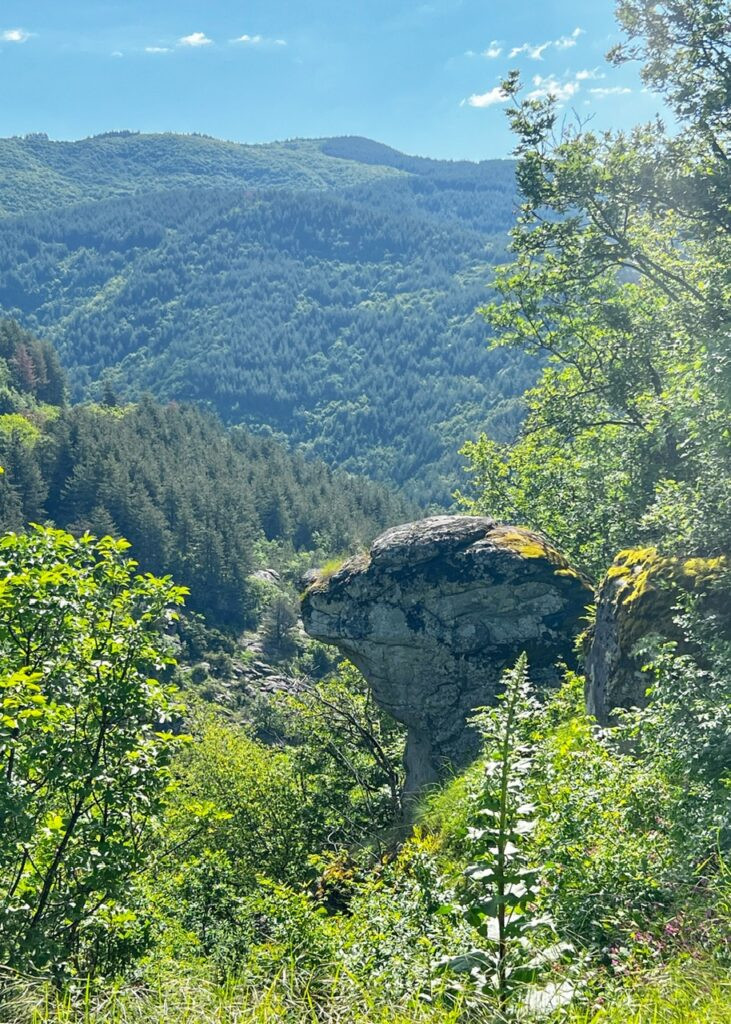
….we would begin heading down on a very steep trail, past a turtle…
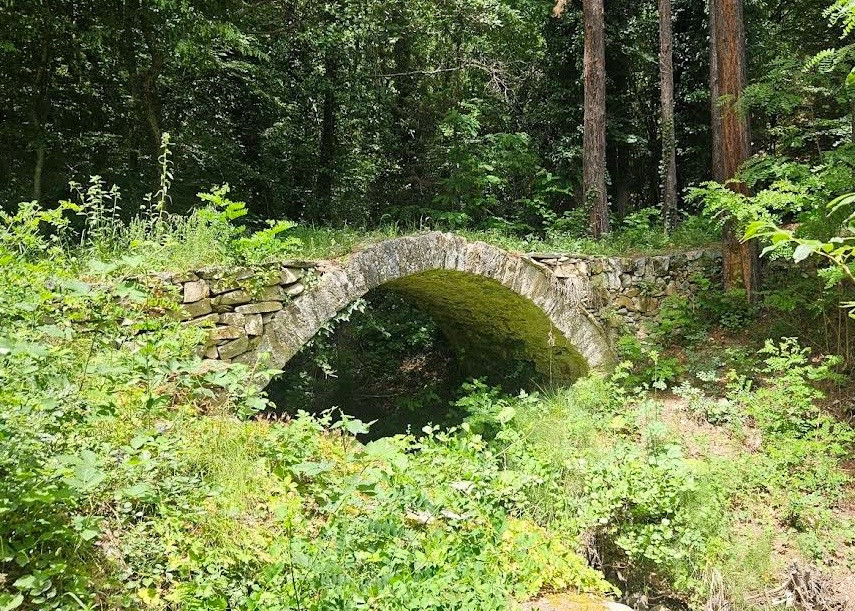
….and eventually to an ancient Roman-era bridge.
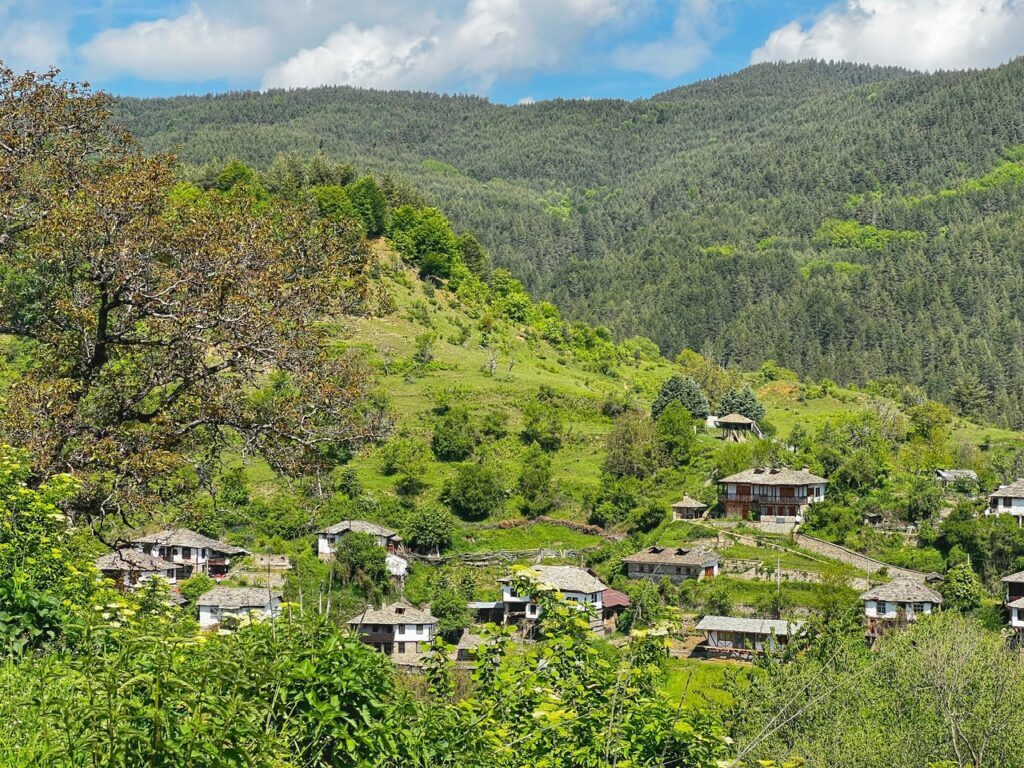
Next, we moved on to the absolutely tranquil village of Dolen, which was on that pre-discovered list of architecturally significant Bulgarian treasures. The village is nestled in a lush amphitheater of Western Rhodope mountains, and contains well-preserved 19th-Century architecture and rich cultural heritage.
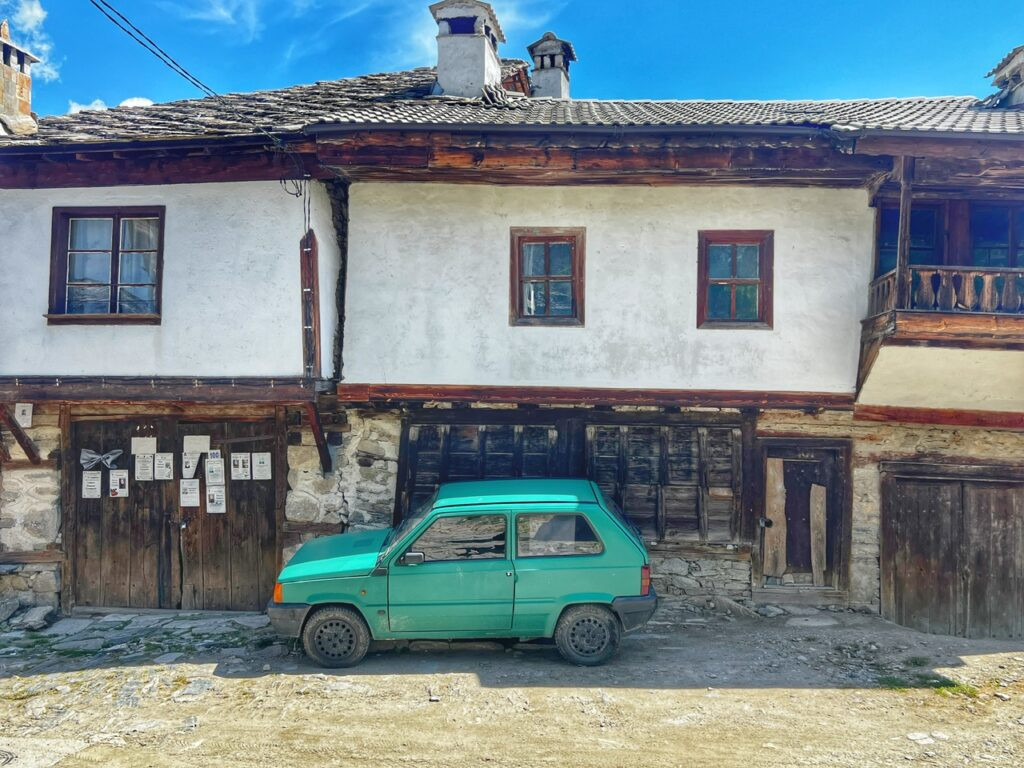
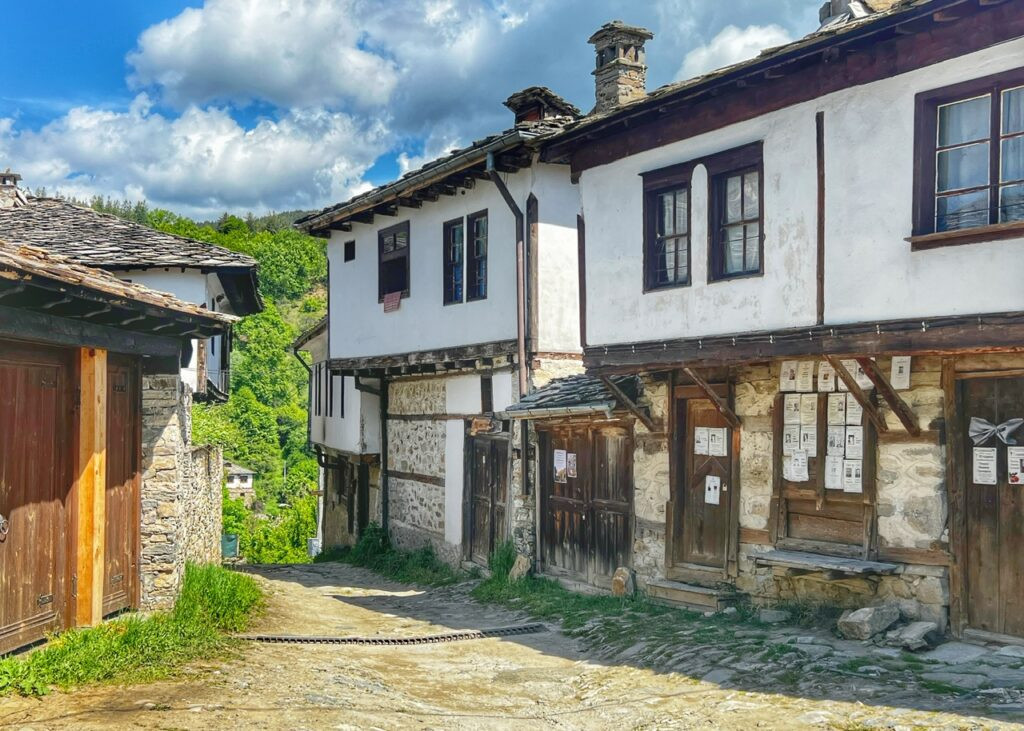
We parked our car on the edge of town and prepared to walk. And although its narrow and winding streets are mostly empty, it was common to see retro Lada cars, which seem like they’d be an absolute bear to drive on these dipping and plunging cobbled works of art.
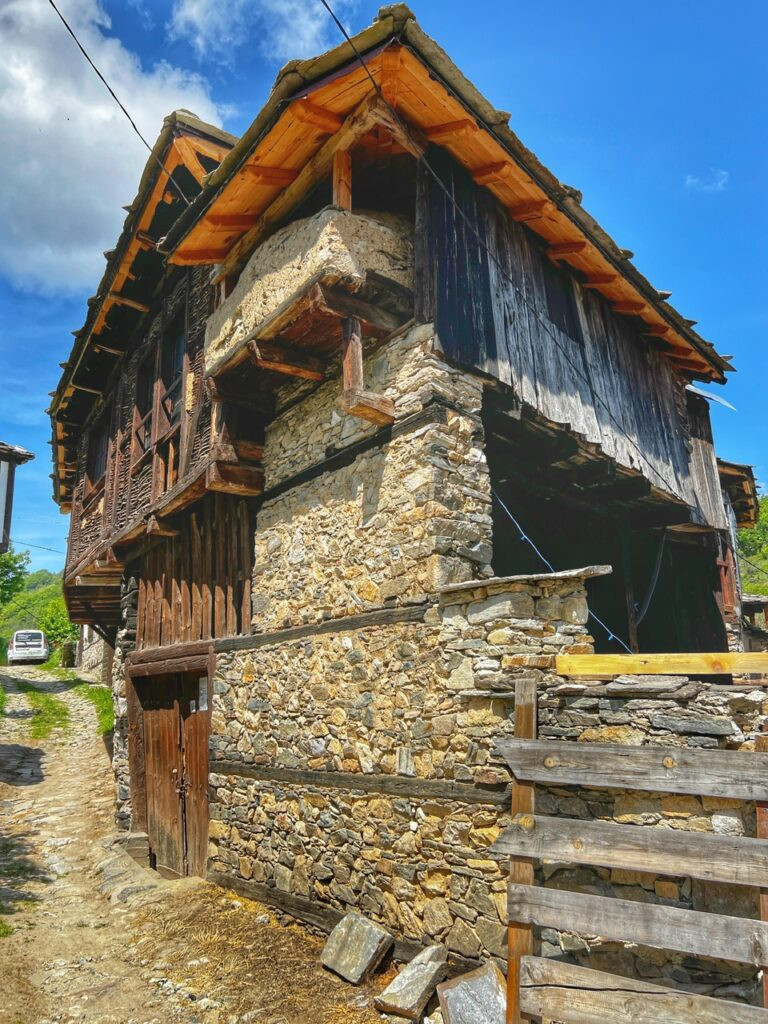
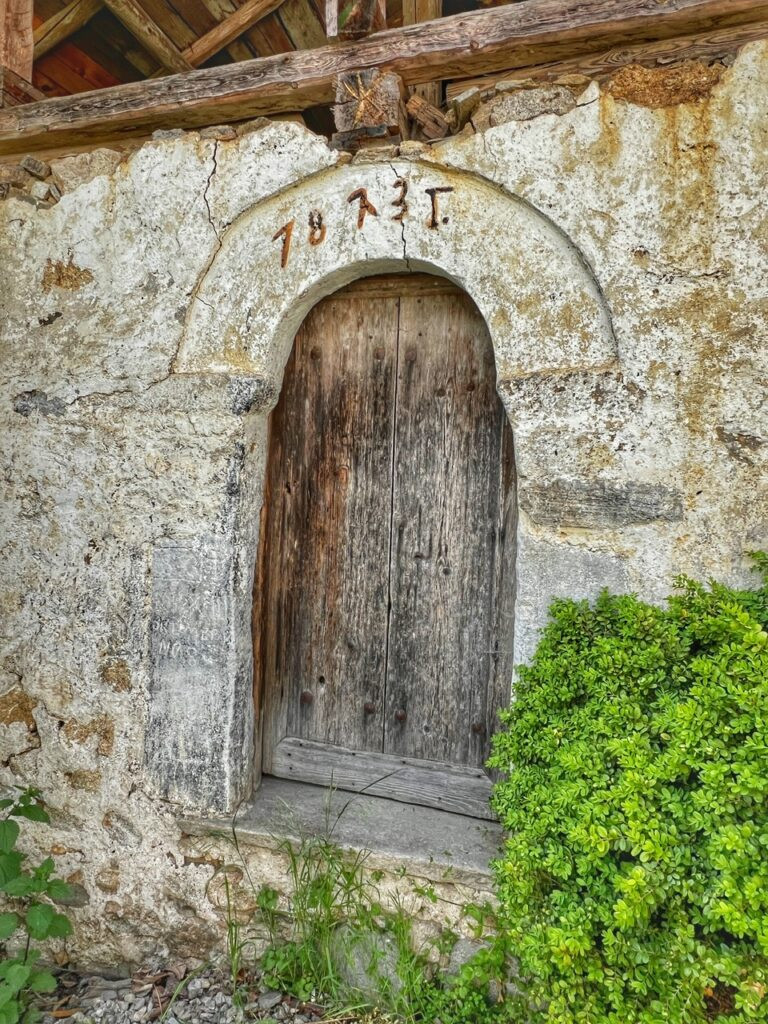
The village boasts plenty of traditional Rhodopean houses with overhanging upper floors, and stone plate roofs, as well as doorways that just beg to be entered.
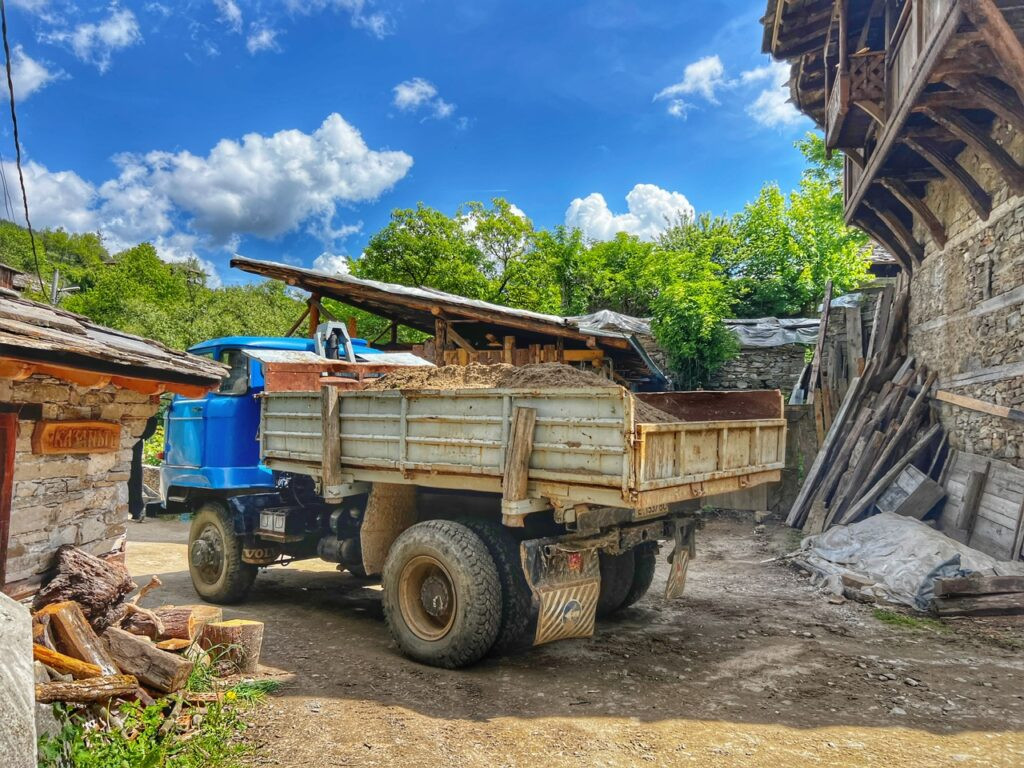
Believe it or not, those Ladas weren’t the only vehicles chugging through the village. We also saw massive dump trucks…which of course are necessities in the many reconstruction and renovation projects.
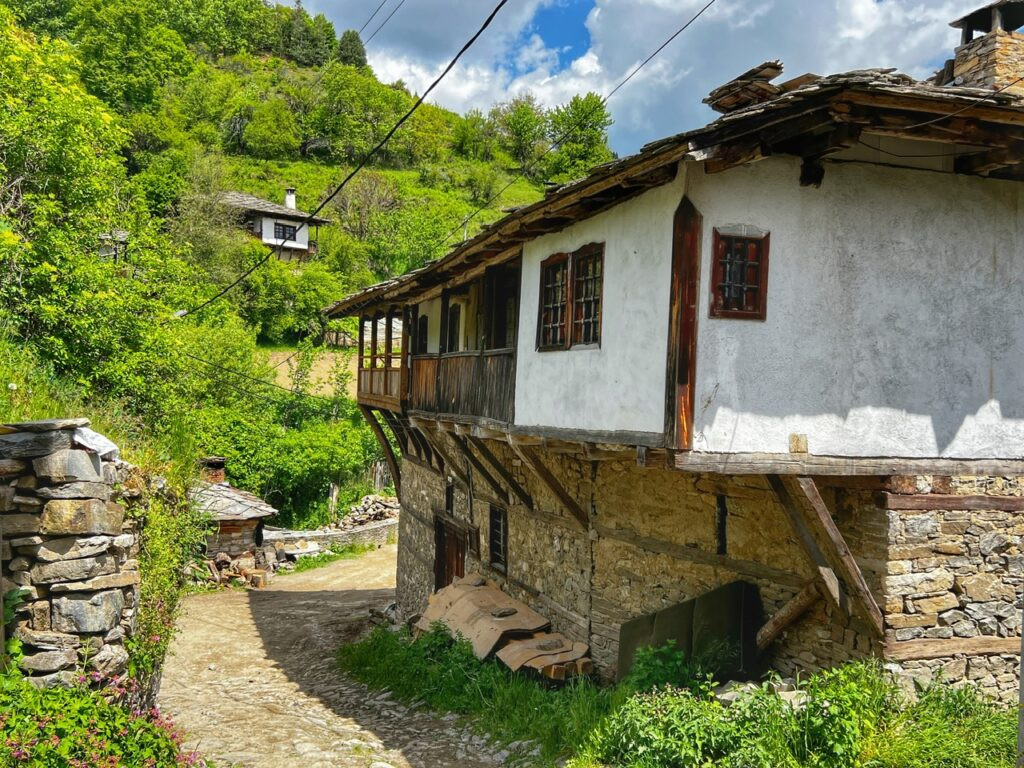
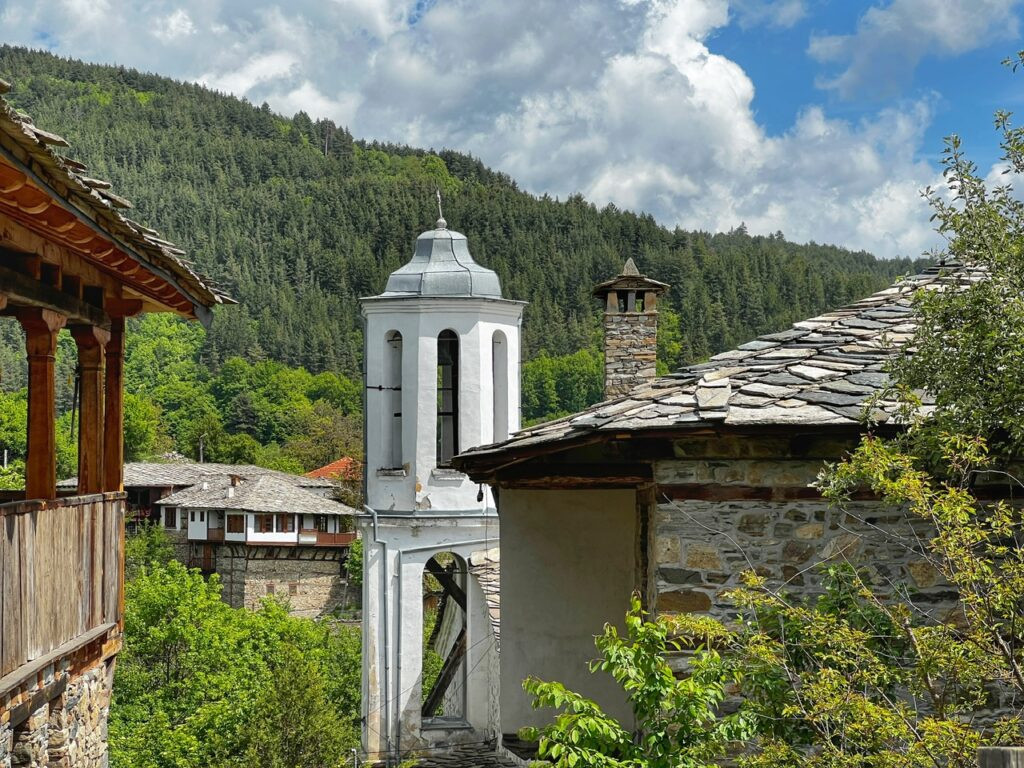
While ambling through the village, we met several friendly locals. Our limited Bulgarian and their non-existent English didn’t give us the ability to fully explain why we two Americans were there, nor offer anything other than a sheepish shrug when they mentioned our presidents’ name.
Fortunately, one of them even introduced us to another local, an English-speaking expat who had moved to the village from Poland 15 years ago, who shared his thoughts on what it’s like to live and buy property in rural Bulgaria. Apparently things have gotten a lot harder with building restrictions throughout the years, and unsurprisingly, more expensive. Interesting…
He also told us of an American artist who lived in the village. She was out of the country, or he would have introduced us. It was definitely the kind of place where everyone knew everyone else’s business.
The 1834 St. Nicholas Church in the middle of Dolen is tucked into the villages’ architectural folds. It’s unusual how the churches are not set apart in Bulgarian towns, unlike many places in Europe.
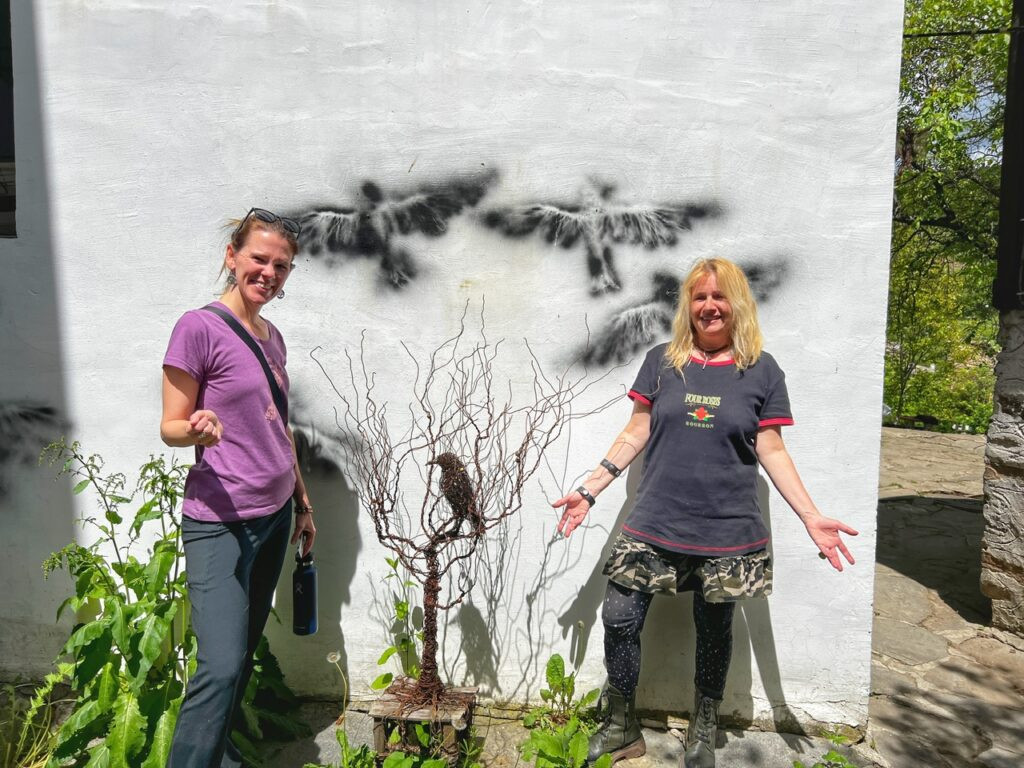
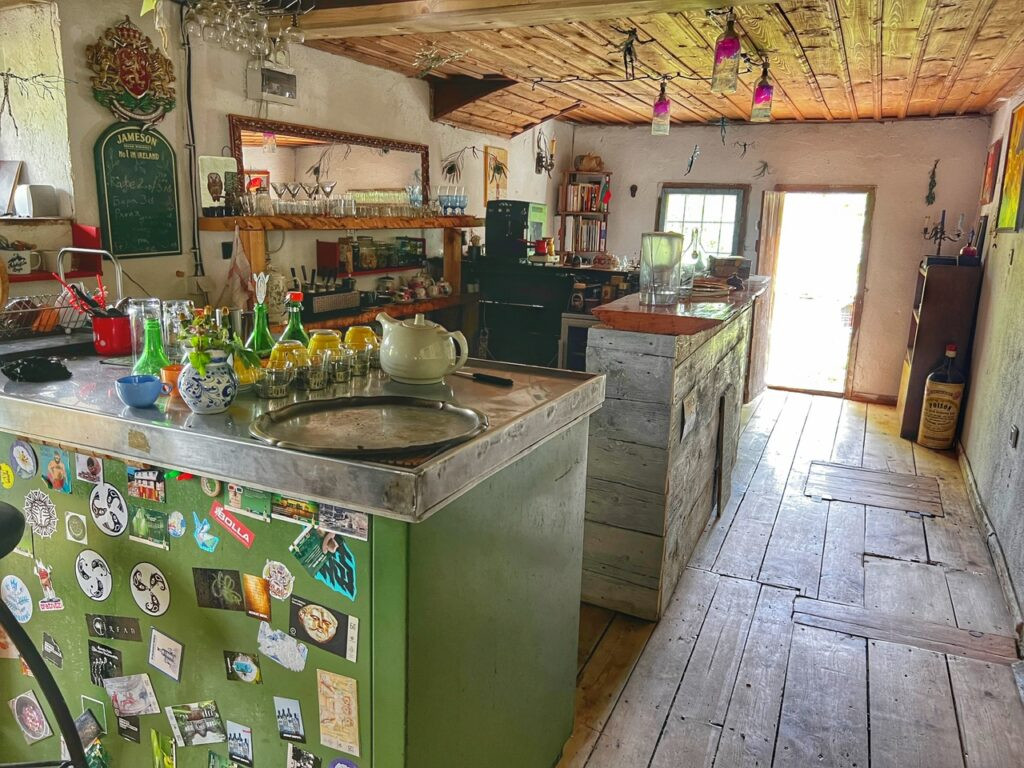
As we wandered on, we continued warmly greeting the people we met, and eventually, we bumped into a Sofianka named Nevena, who invited us into her guesthouse to see her extraordinary wire art and have a chat.
We asked her about living in this seemingly off-the-grid village and were especially curious about how she gets her groceries because there are no markets. She told us there is a local lady in the village who prepares and sells food and she buys it from her. She also goes to Satovcha every couple of weeks to buy things in the city, but a car is pretty necessary. It would definitely require some logistical maneuvering.
The inside of her guesthouse. She was getting ready to host an exhibition this upcoming weekend.
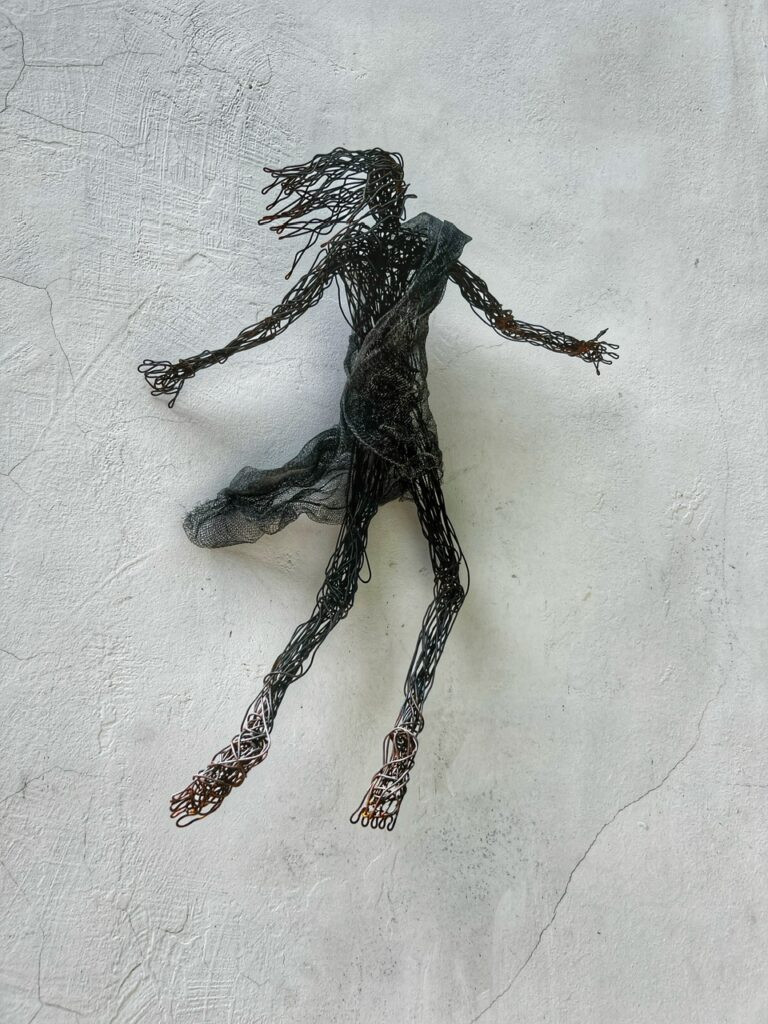
Not only was Nevena very friendly, but quite gifted as well.
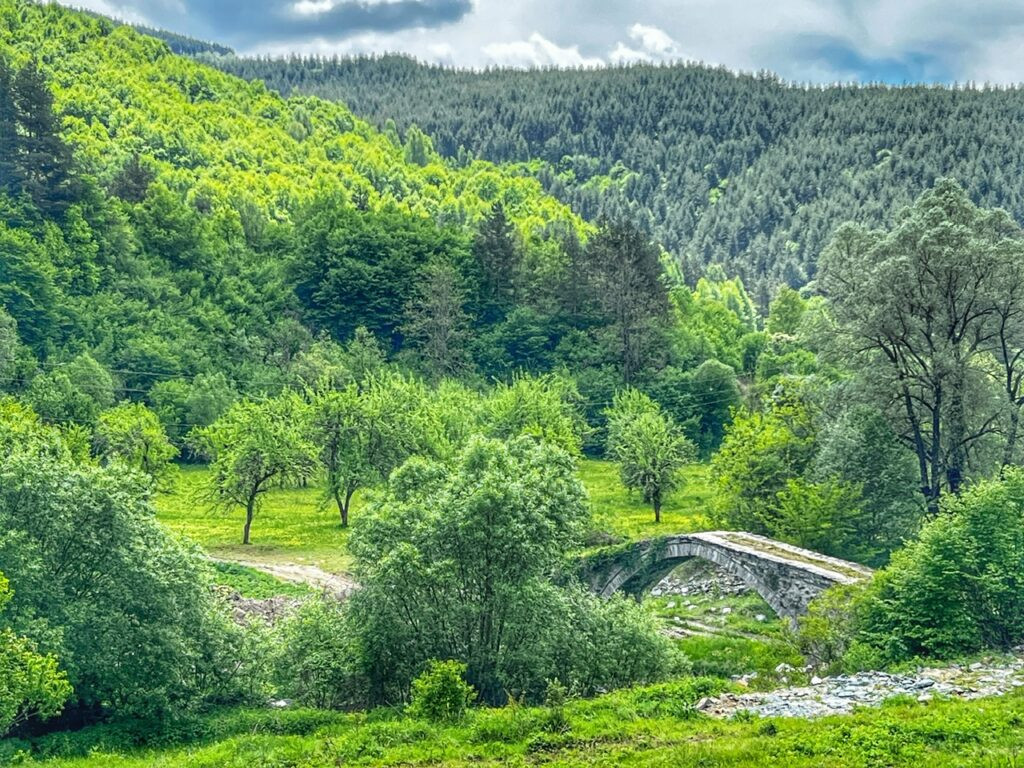
On our way to Satovcha, we stumble upon another ancient Roman bridge, along the side of the road, after our crazy descent to see the other one. They are seriously a dime a dozen around here.
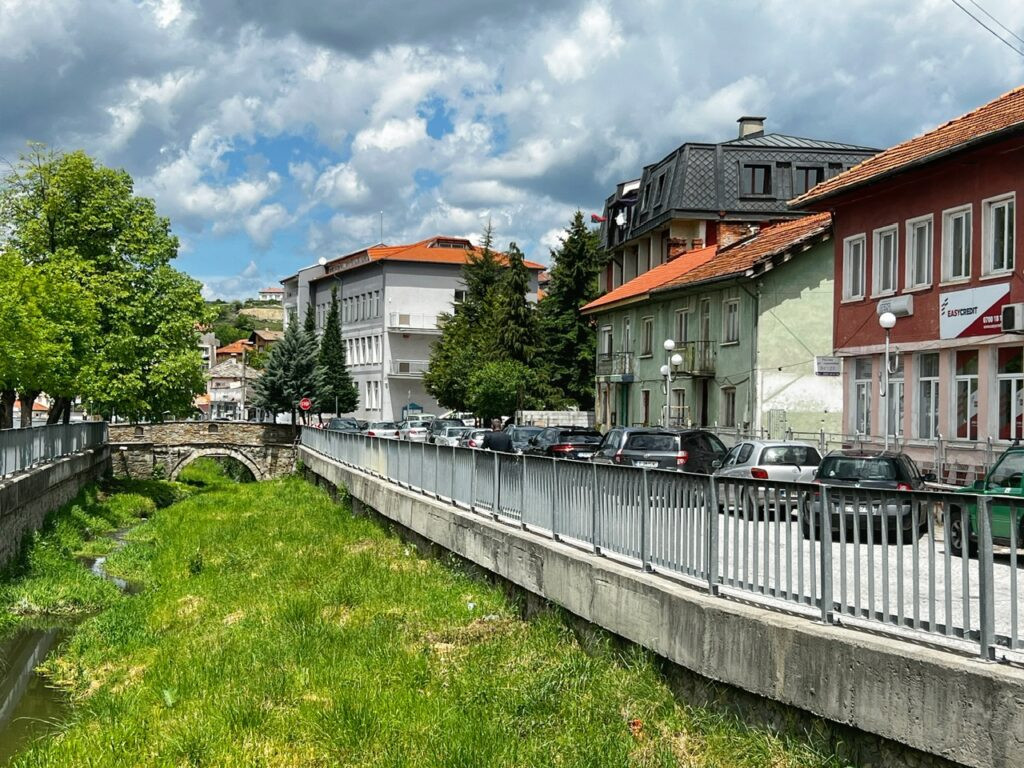
Arriving to the big city of Satovcha, population 1700. Here we pulled over to eat bread rolls with some ajvar (red pepper sauce) and a slab of salty Bulgarian cheese…our Mediterranean lunch of champions when we’re on the go.
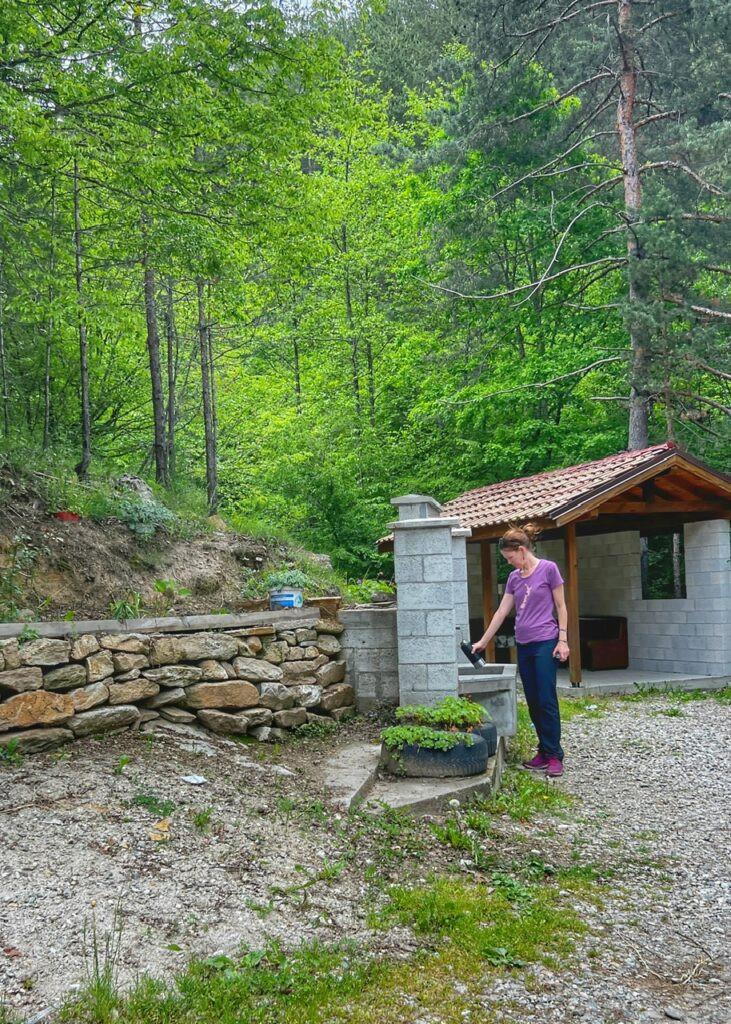
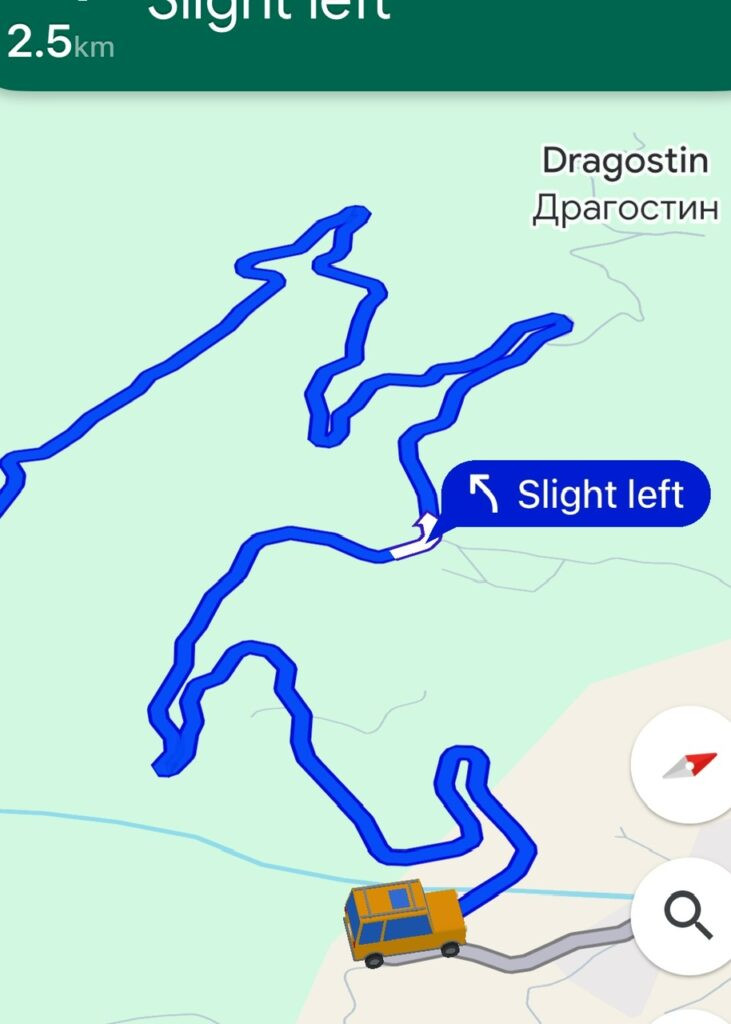
Filling up on the side of the road has a whole different meaning on the Balkan Peninsula. From here, we found ourselves back in Gotse Delchev, and then launched our car up a tossed wet -noodle-of-a-road on the other side of the mountain…
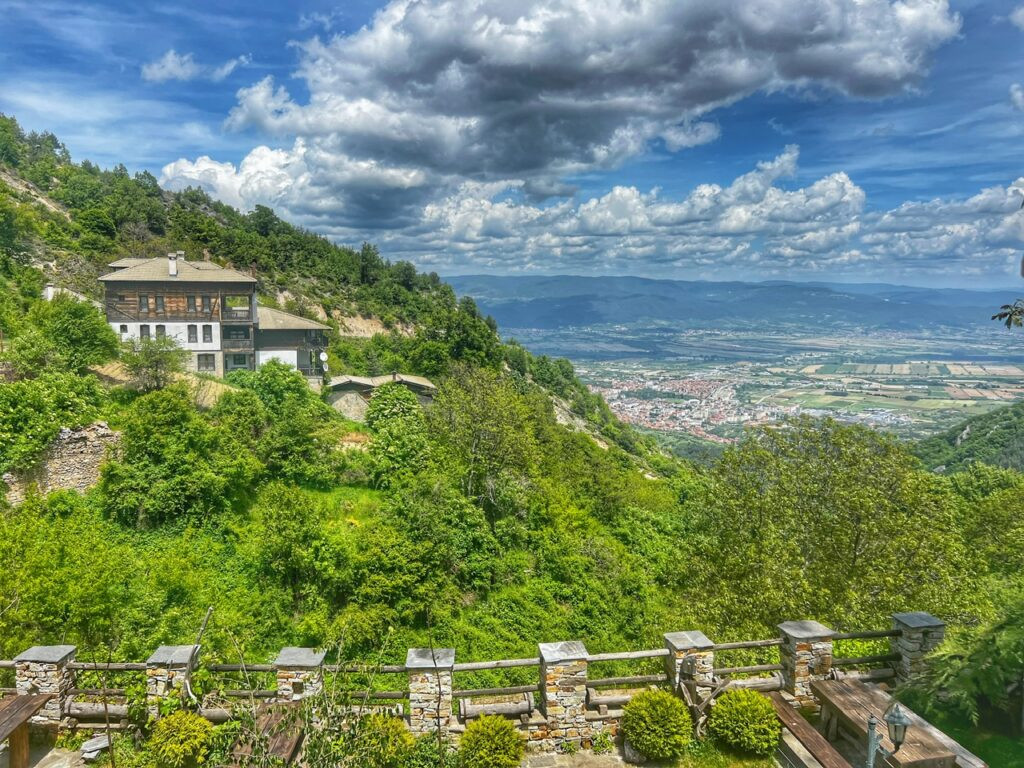
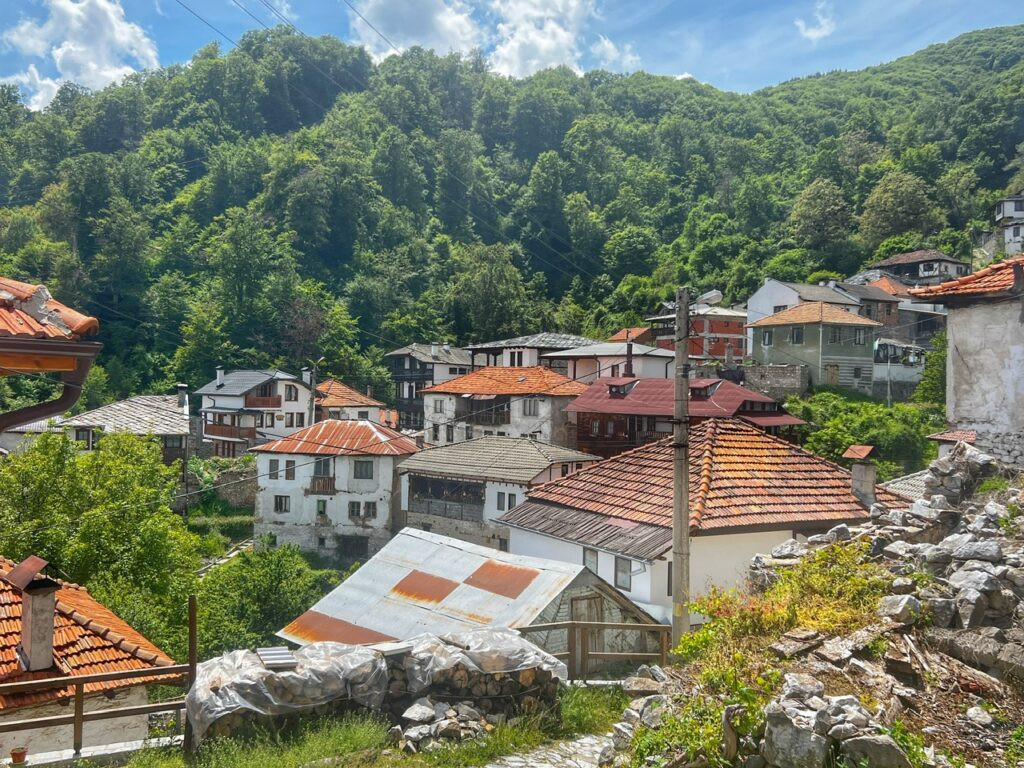
….until, 8 km later, we reached the climax in Delchevo which offered an insane view of Gotse Delchev and the Rhodopes far below.
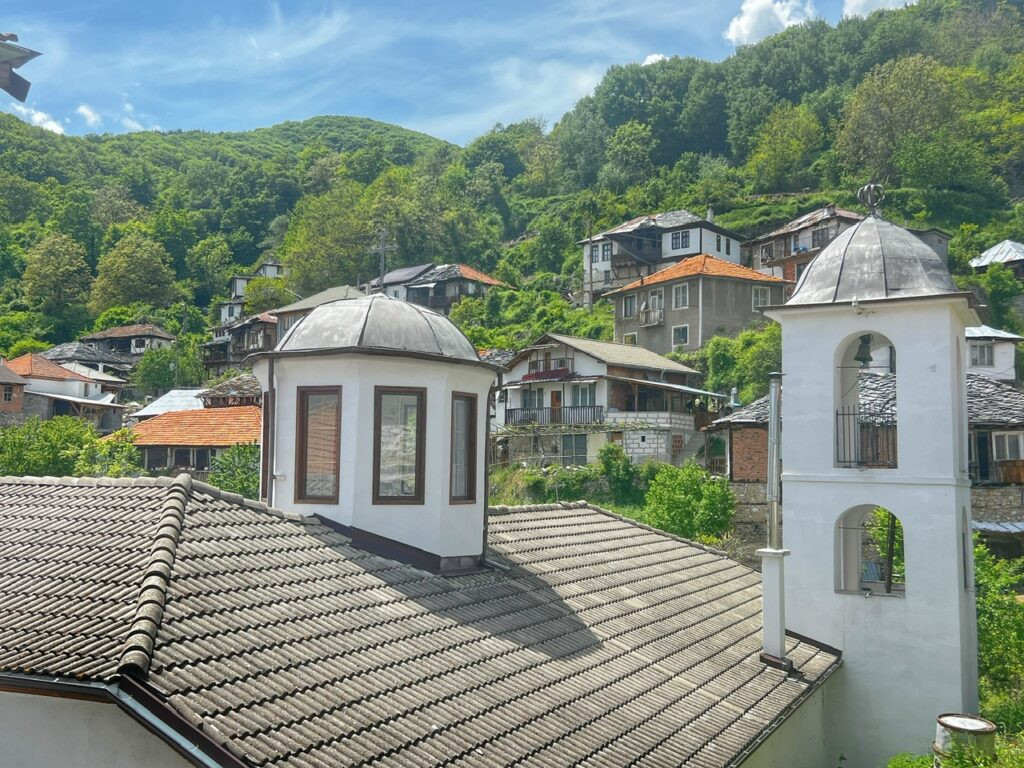

This picturesque village at 1024 meters felt like a bona fide mountain escape. Another church, mingled in with its surroundings. With these views, Delchevo seems like a great place to grab a bite, or have an overnight, at the Guest House Shapkova Kushta.
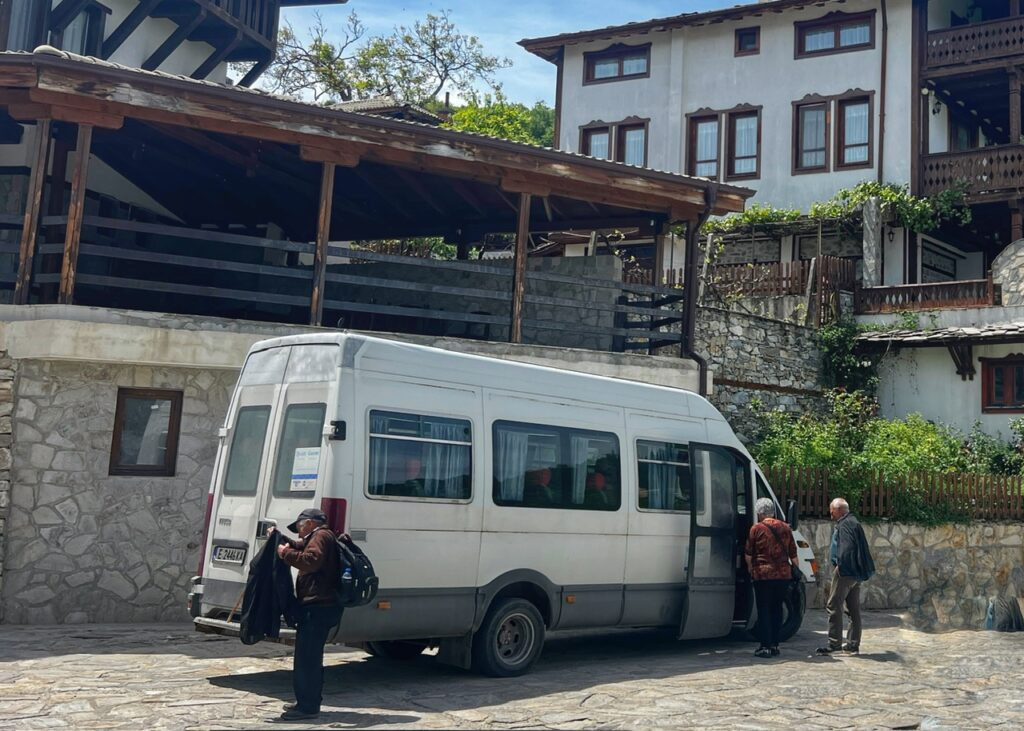
And it’s even serviced by a mini bus, which was taking local residents down to Gotse Delchev.
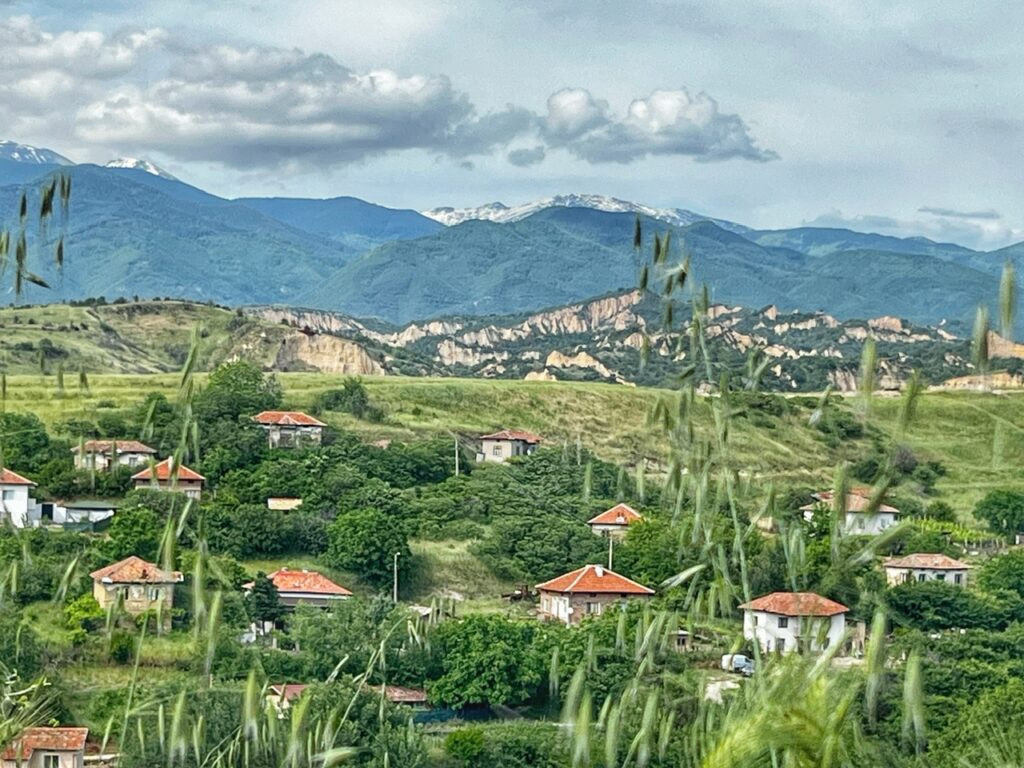
As we headed back to Sandanski, we drank in some more delicious views including that of Vinogradi village, which in this photo, is further layered by the sandstone Melnik pyramids, and the snow-capped Pirin Mountains. What a perfect side trip from Sandanski!


